Lake Atitlan – Guatemala’s Alpine Wonder
This is my second post from the wondrous country of Guatemala which, despite years of civil unrest, finally seems to be returning to a semblance of normalcy that is seeing the return of tourists to the most popular areas. The first post highlighted the amazing market in the mountain town of Chichicastenango where I also got my first look at the syncretic religion practised by the K’iche’ Maya of the region. It definitely whetted my appetite to see more of this most unusual Central American country. While I am writing this at the height of the Covid-19 pandemic that has effectively ended tourism as we know it, I am hopeful that there will be a worldwide return to normalcy as well, I just don’t have a clue when. Once it does, this post might serve as an inspiration to visit one of the most beautiful places I’ve ever seen or been – Lake Atitlan. If, God forbid, things never return to normal and Lake Atitlan proves impossible to visit in the future, then let this post stand as a paean to its beauty.
Alison and I are in country number six of Victor Romagnoli’s specially created itinerary of every land in Central America for Canadian based Adventures Abroad. Our bus chugs up and over the mountains between Chichicastenango and Lake Atitlan which, as the crow, or more likely the vulture flies, is not that far away. We cross the Pan-American Highway at Los Encuentros and pass through the small city of Sololá which, like Chichicastenango is noted for its biweekly markets. Despite the short distance we have travelled, we have moved from the heartland of the K’iche’ Maya to that of the Kaqchikel Maya who speak a different language and whose native dress differs,. The two were traditional enemies and the Kaqchikel helped the Spaniards conquer the K’iche’ way back in the 1500’s, but not so long ago that there still isn’t bad blood between them. From the streets of Sololá we get our first glimpses of Lake Atitlan, almost 2,000 feet (600 metres) below.
Creation of Lake Atitlan
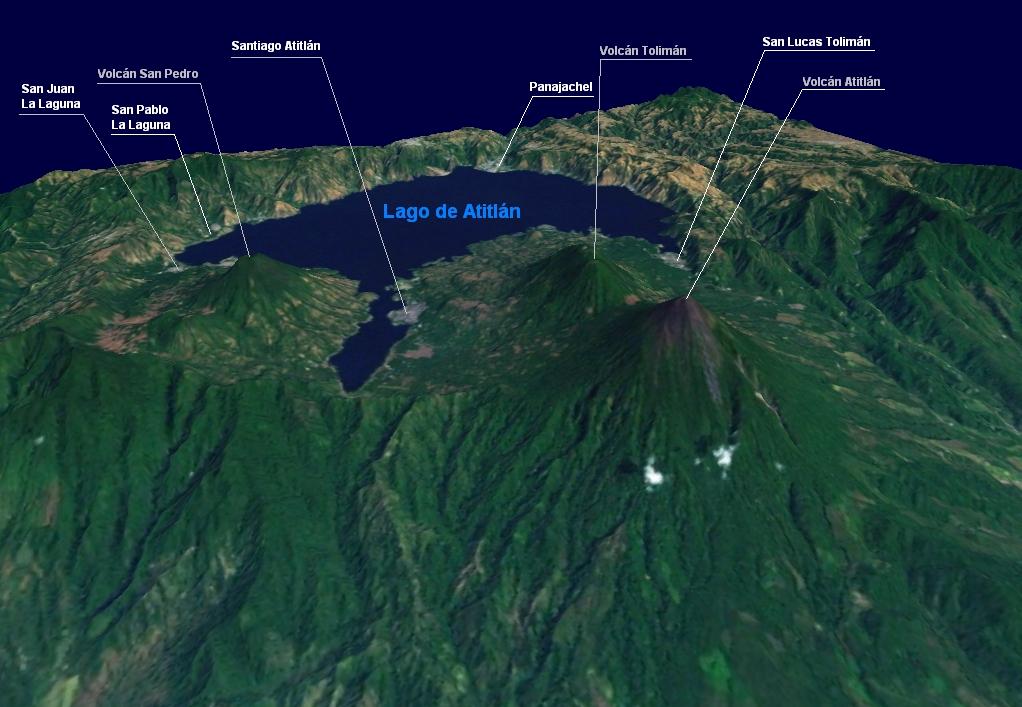
About 85,000 years ago there was one super volcano named Los Chocoyos that erupted in an event that blew it to pieces, sending ash as far away as Florida and Ecuador. It is reckoned to be one of the greatest volcanic eruptions of the last 100,000 years. Instead of of a huge mountain, there was now a huge hole, more properly a caldera, that gradually filled with water to create Lake Atitlan, much like Crater Lake in Oregon. From the map above you can get an idea of just how big Los Chocoyos was compared to the three volcanoes in existence today that sprung up after the explosion. They are veritable pimples compared to the original. Similar to Crater Lake it is also very deep, up to 1,120 feet (340 metres) with an average depth of 720 feet (220 metres) so it’s a long way to the bottom for those who drown on its surprisingly rough waters.
The great polymath and personal hero of mine, Alexander von Humboldt is often quoted as describing Lake Atitlan as the most beautiful lake in the world, yet I can find no record that he ever visited Guatemala during his epic expedition to Latin America between 1799-1804. Almost everywhere you go in Latin America, he shows up in statues, parks and street names, but the Lake Atitlan quote was either apocryphal or based on hearsay. Either way it doesn’t matter because I’m about to find out for myself as we pull into the mirador for a look at Lake Atitlan from above.
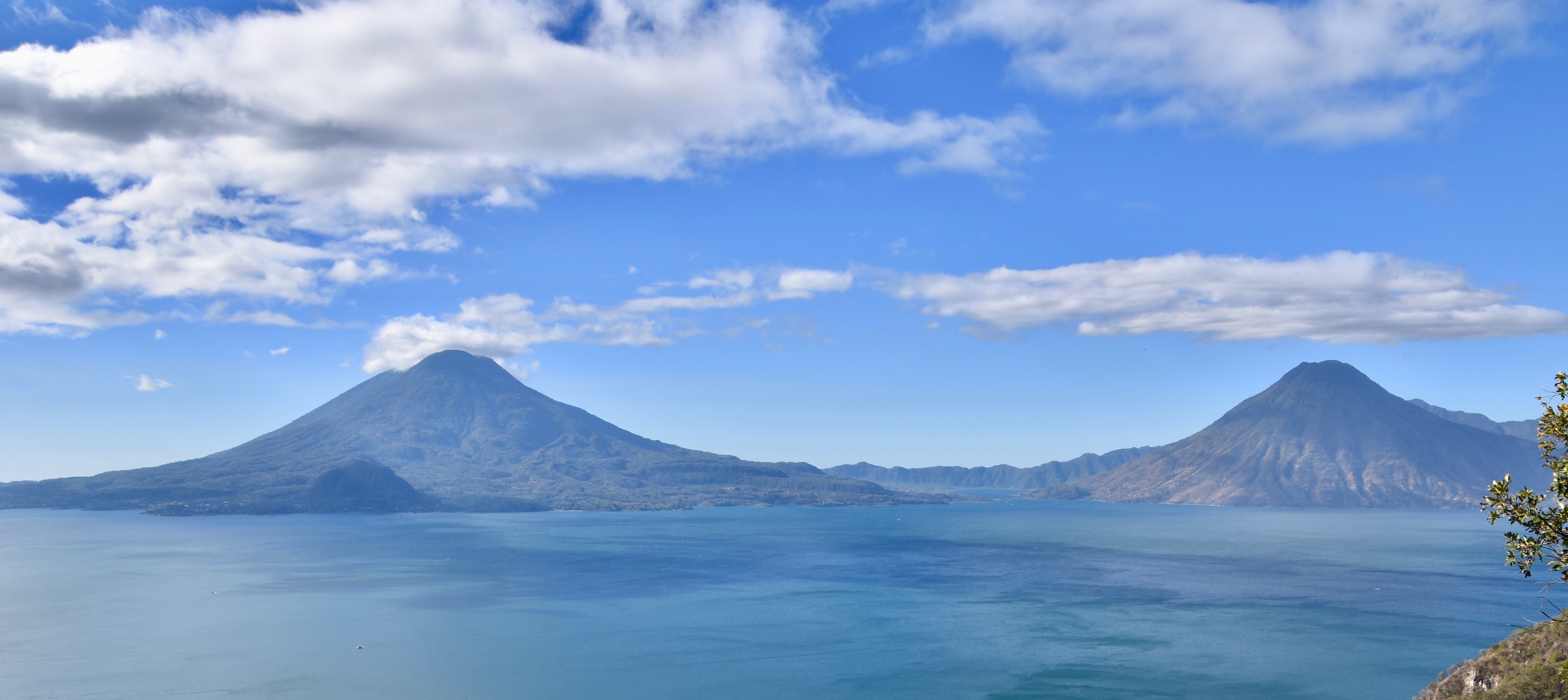
Alexander, you were right. This is a stunningly beautiful lake. Below is the view looking south and you can barely make out our destination, the town of Panajachel on the left.
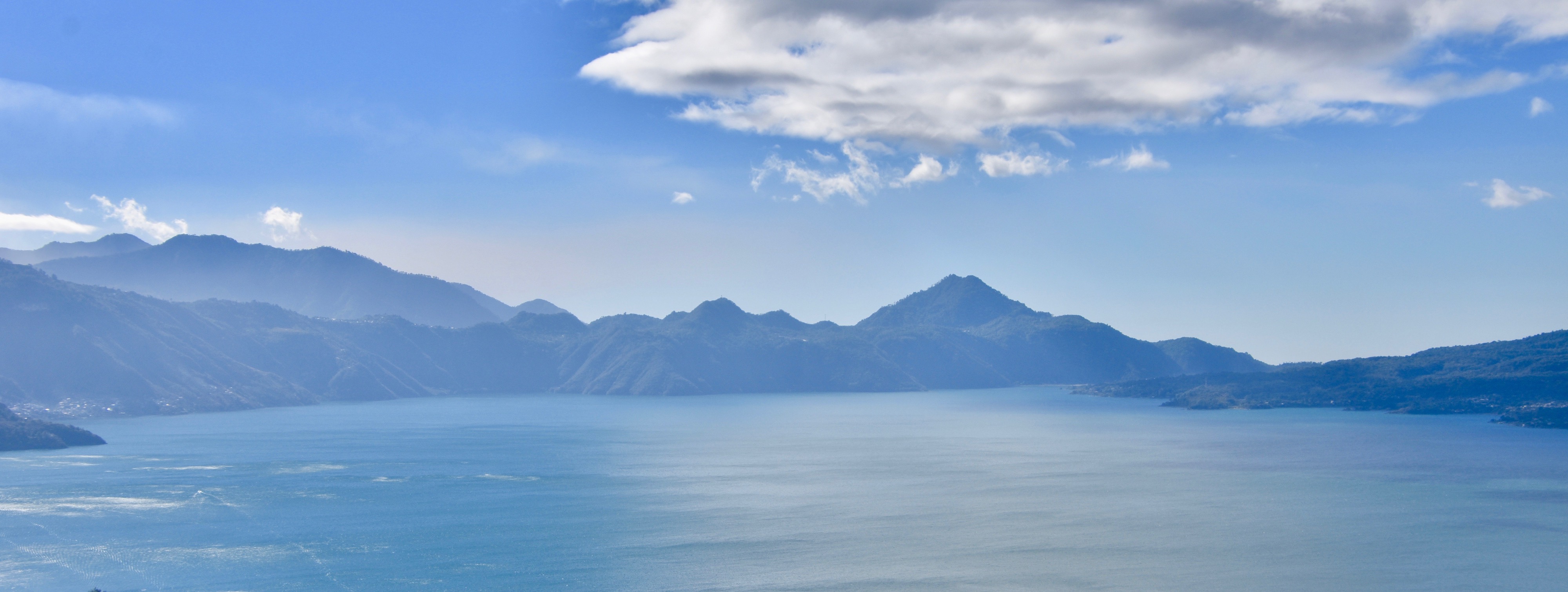
If there was ever a mirador from which you want to get your picture taken this is it. Photography buff Brian Palardy took this photo and it is one our favourites from the entire trip.
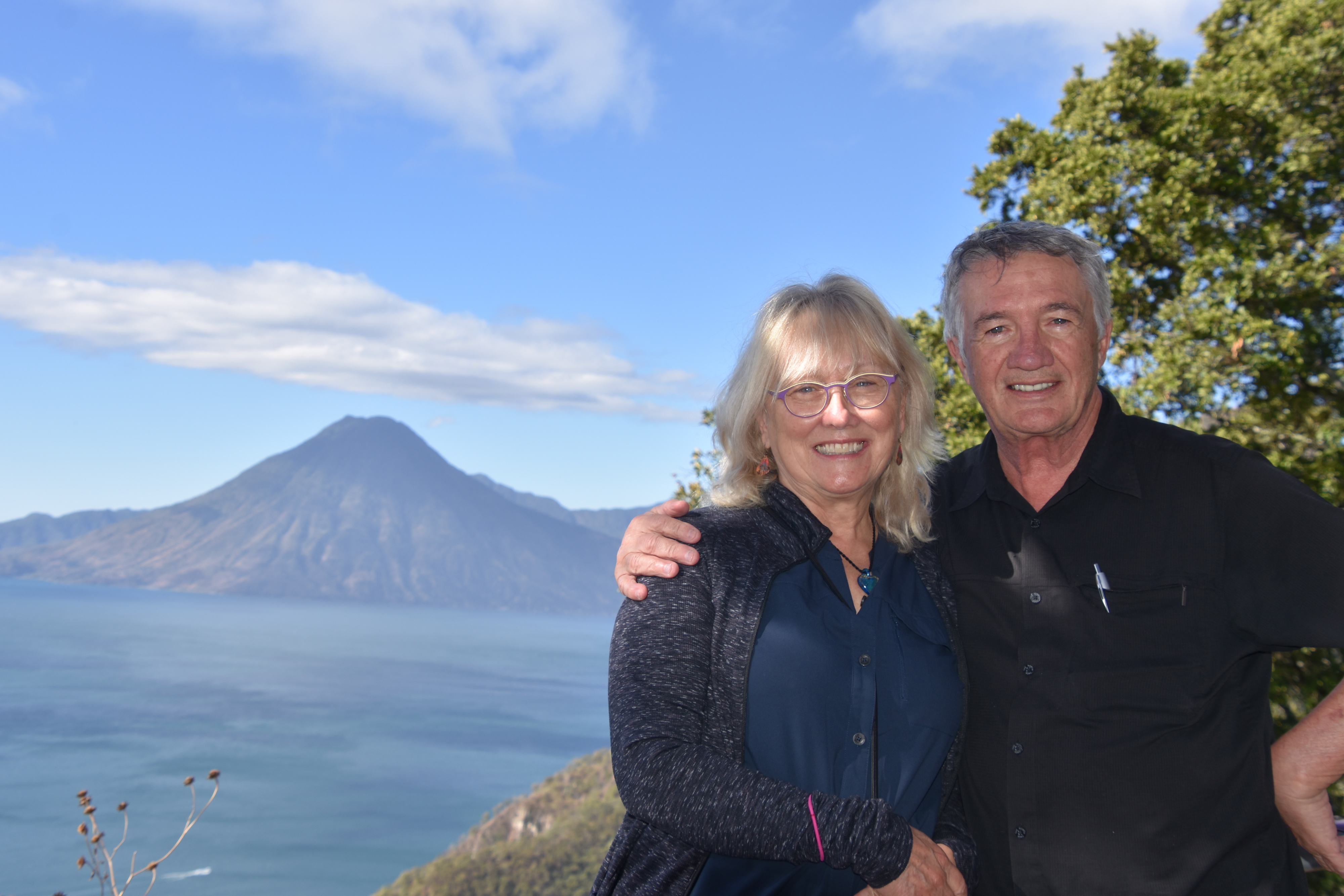
Tomorrow we will be out on the lake, but for today we will content ourselves with settling into Panajachel and exploring one of Guatemala’s most famous tourist towns.
Panajachel
Panajachel or just ‘Pana’ as everybody seems to call it, is the first real tourist town we have been in for it seems like weeks, or at least the first town with any recognizable amount of tourists. After leaving Costa Rica, our Adventures Abroad group was about the only bunch of tourists, other than a few backpackers, in Nicaragua, El Salvador and Honduras. This place almost comes as a shock with its narrow streets not exactly thronged, but with way more tourists than we have been used to seeing. There are restaurants and handicraft stores everywhere, but overall most of what is being offered for sale is crap. There are an amazing amount of really cheap t-shirts with dumb sayings on them that an amazing number of people are buying and wearing. I can never figure out why dumbasses want to let everyone know that that’s exactly what they are. There are also quite a number of seedy looking, rheumy-eyed expats that look like they would fit right into a Graham Greene or Malcolm Lowry novel.
I’m not saying that I didn’t like Panajachel, I just found it jolting after the relative authenticity of the places we had just come from. The town has a fabulous location on Lake Atitlan and Alison and I very much enjoyed walking in a loop around the town and returning along the waterfront. However, in preparing for this post I found that I never took a single photo of the place other than of the hotel.
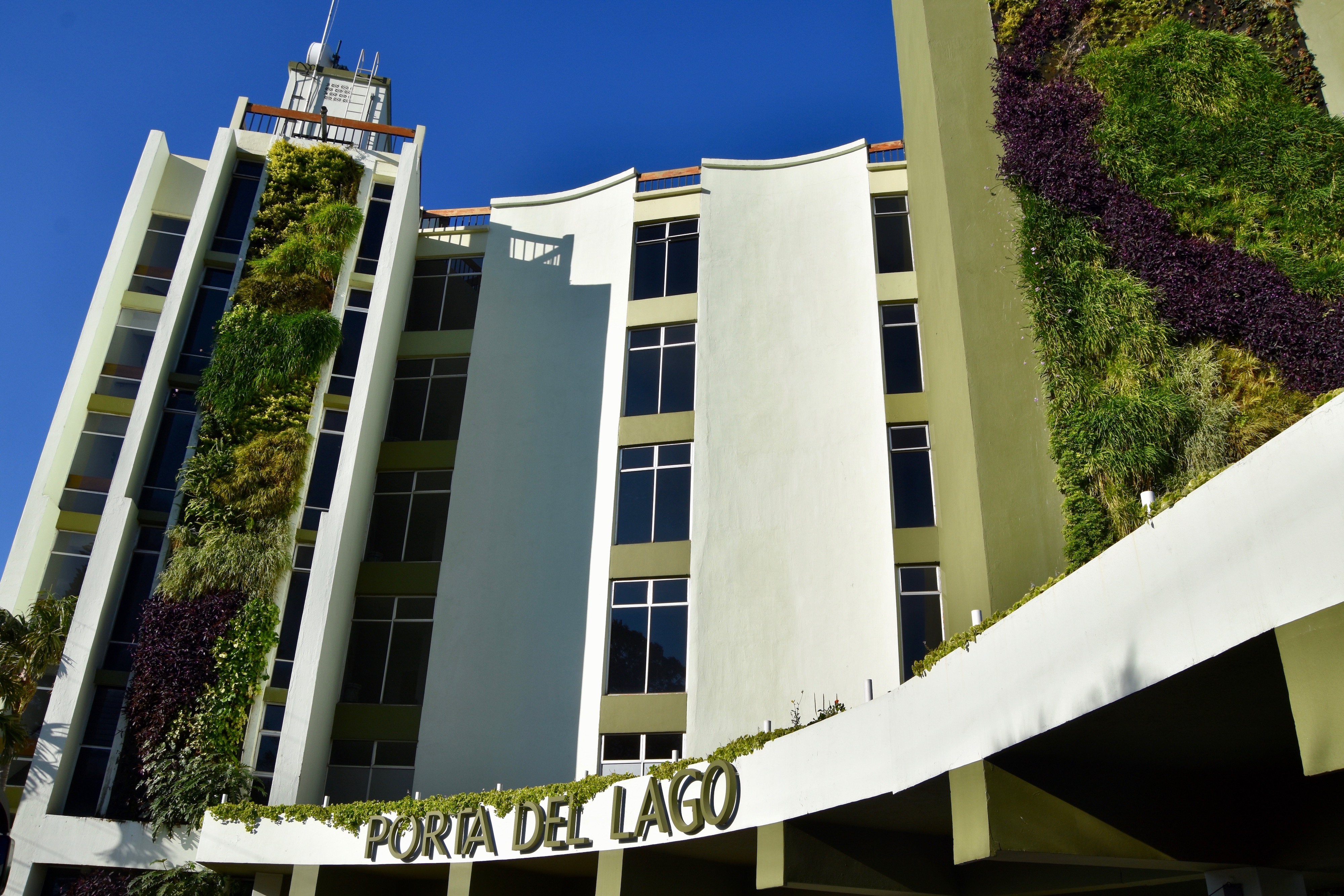
The Porta del Lago which I note is temporarily closed because of the pandemic, describes itself as a boutique hotel with which I might quibble. The Mayan Inn where we stayed in Chichicastenango and a number of other others on this trip were boutique hotels, this is not. However, it is still a very fine hotel with absolutely world class views from the rooms. This is the view from our room, 503.
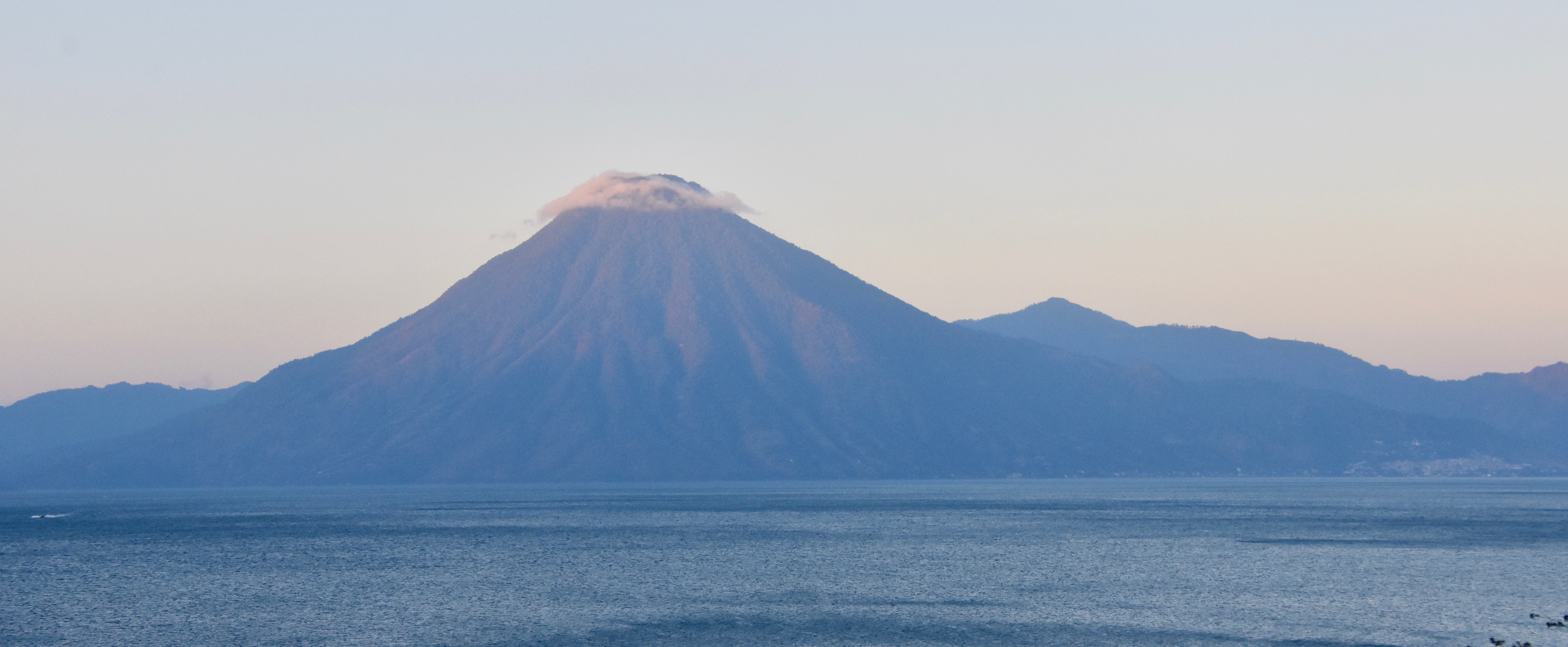
It has a large swimming pool, some very nice Mayan handicrafts for sale and puts on an excellent breakfast buffet. I have no hesitation in recommending it to anyone who might get to Panajachel in the future.
On Lake Atitlan
In reading the itinerary for this trip one of the things I was most looking forward to was the day we were to spend exploring Lake Atitlan and a couple of its villages. Well, that day has arrived and before nine we are headed the short distance to the waterfront to board our boat and cross the lake to the town of Santiago Atitlan. It’s a beautiful day for a boat ride and soon we are pushing back from the dock at Panajachel and headed out on the open water.
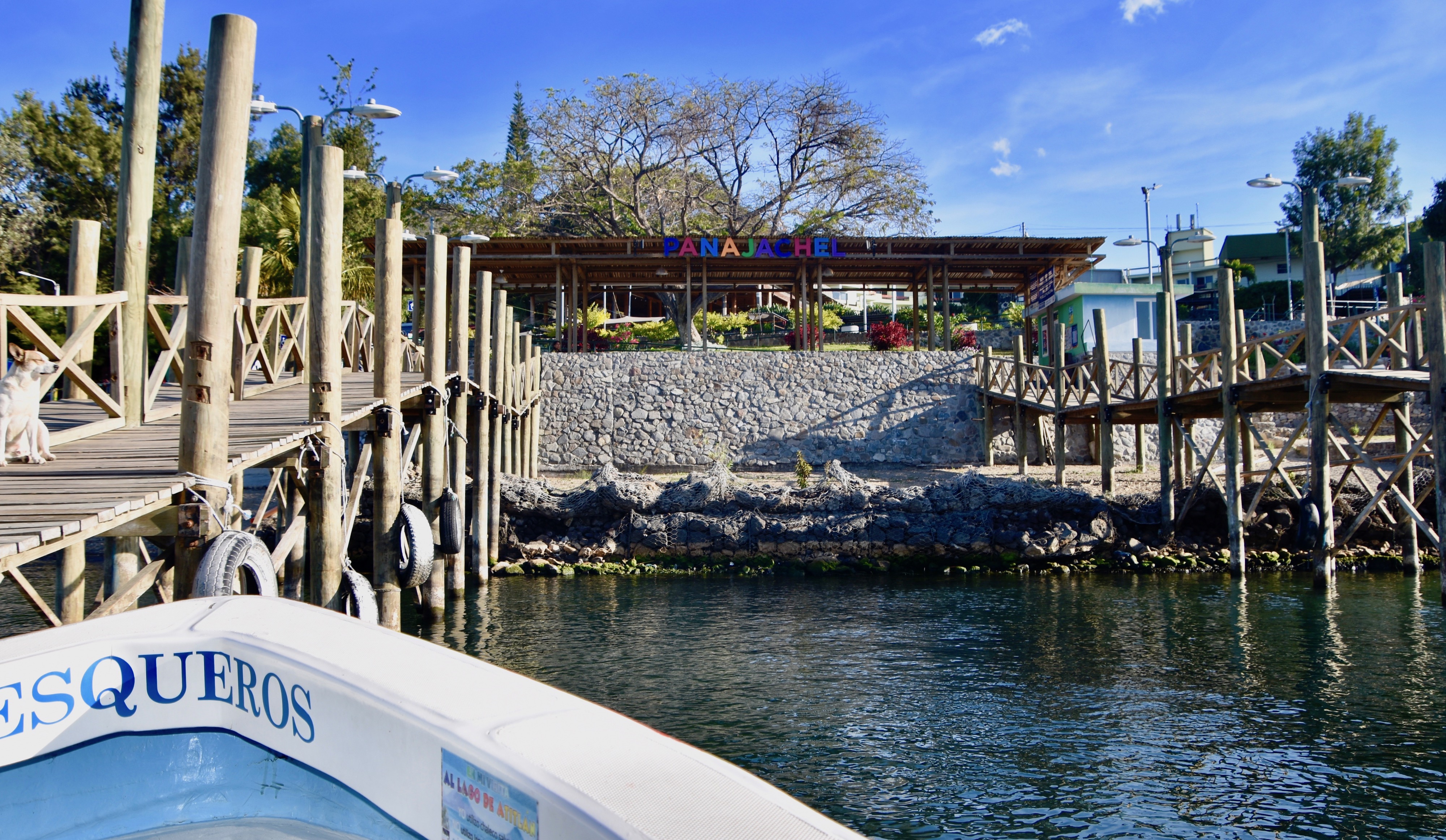
Now I mentioned that Alexander von Humboldt thought Lake Atitlan to be the most beautiful lake in the world, even though he apparently never actually saw it. However, one person who definitely did see it was the British writer Aldous Huxley, author of Brave New World among other works. In his travelogue Beyond the Mexique Bay he compared it to Lake Como in Italy, but thought that the addition of volcanoes to the scene made it “really too much of a good thing.” Sorry, Aldous, but I disagree. These are the three volcanoes of Lake Atitlan and they don’t in any way detract from the grandeur of this lake.
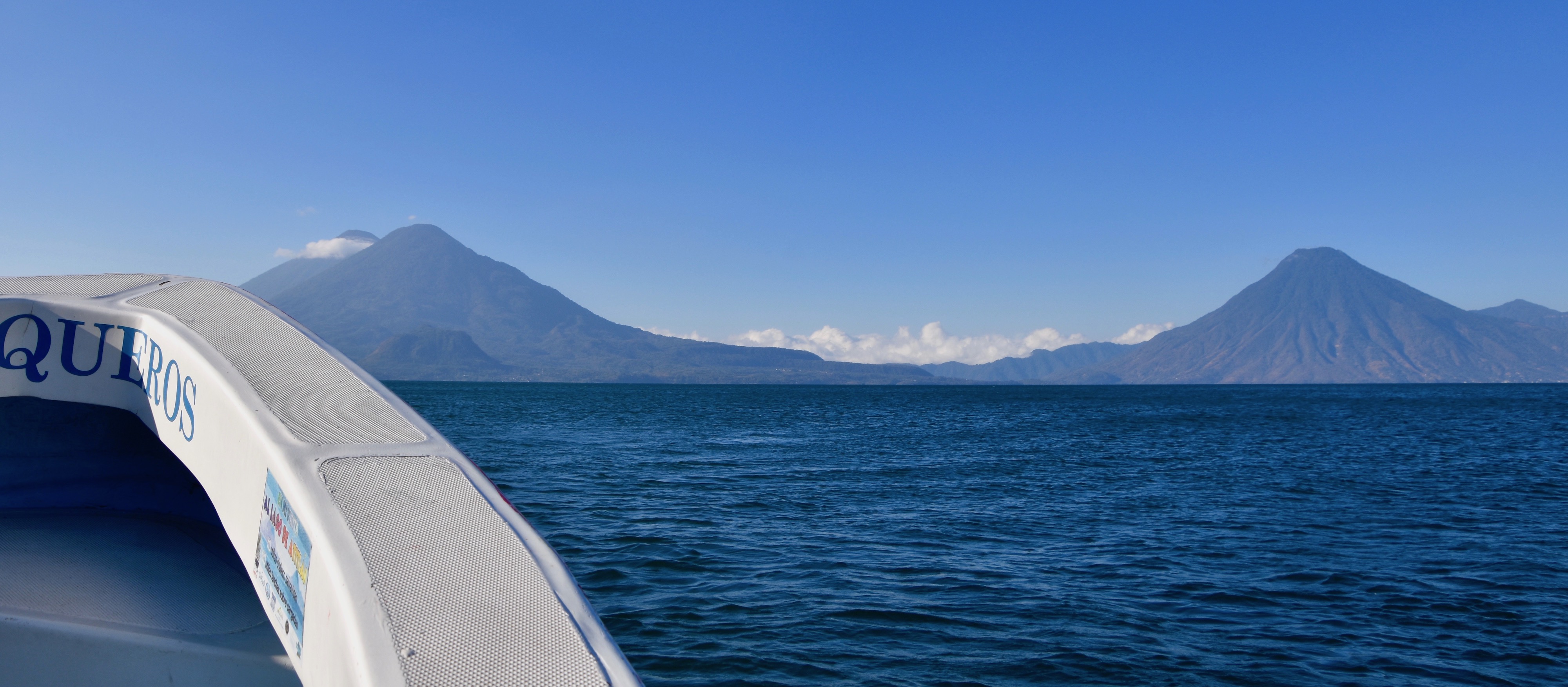
However, all is not sweetness and light when it comes to Lake Atitlan. Guatemala is miles behind most countries when it comes to protecting the environment and that has had a very deleterious affect on this lake. The combination of high phosphorus fertilizers and raw sewage draining into the lake has created algae blooms and cyanobacteria that is lethal to the lake’s eco system. The system may have been able to resist these effects but for the introduction of a species of bass in the 1950’s for the purposes of creating both a sport and a food fishery. As usually happens when man tinkers with nature, this backfired spectacularly. The bass ate their way through the native fishes and when they were gone, even ate the ducklings and chicks of ducks and grebes that were unique to Lake Atitlan. By 2010 the lake was faced with the prospect of actually dying.
The good news is that since this near death experience the process has begun to be reversed as the use of fertilizers has been dramatically reduced and several sewage treatment plants have curtailed the draining of raw excrement into the lake. Right now the situation is apparently improving although nowhere near back the the way the lake was before the bloody bass were introduced. The Atitlan grebe is extinct and will never return. What is also gone, thankfully, is the horrible smell that cyanobacteria gives off, so this morning the lake looks blue and pristine, even if I know it’s not.
One other thing about Lake Atitlan which man can’t interfere with. That’s the Xocomil. It is a wind that is unique to the area and is created by warm Pacific air meeting cooler northern air over the waters and boy is it blowing today. The water might look calm from the photo above, but it’s actually rough as hell and the boat slams into the waves every five seconds or so sending a jolt down the spine that I’ll be paying for in days to come.
I can’t believe the local people are out in their makeshift boats with the prow just barely not going under with each approaching wave. They don’t seem too concerned so neither am I.
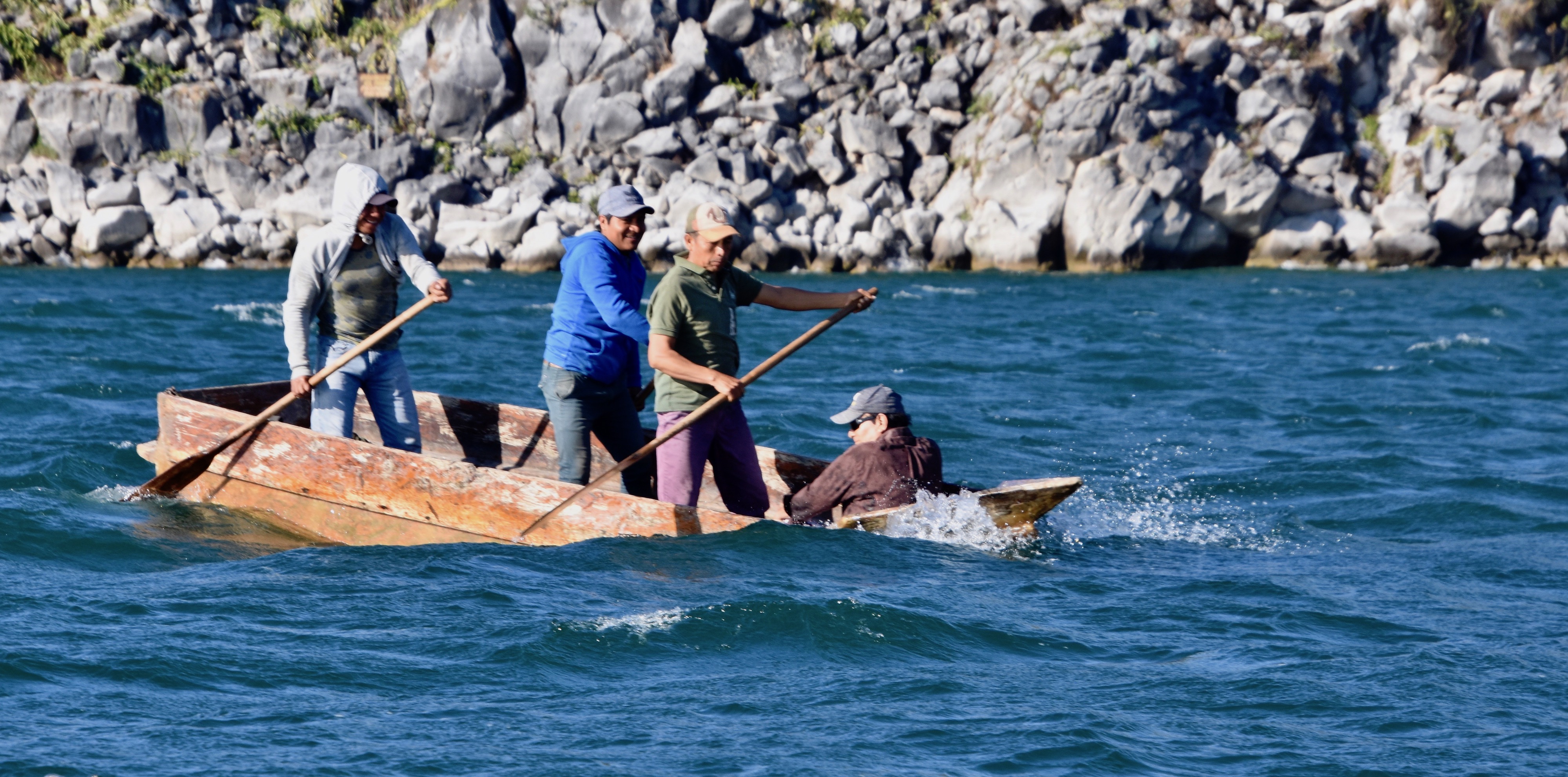
Santiago Atitlan is located inside a long inlet which we enter after about a thirty minute crossing of the lake. The roughness subsides and we pull up to the dock where a number of people are collecting lake grass which I presume will be used as a type of fertilizer. I know I used to harvest eel grass every year from just off my wharf to use as a type of compost on my flower beds until the invasive European green crabs arrived and destroyed the grass beds.
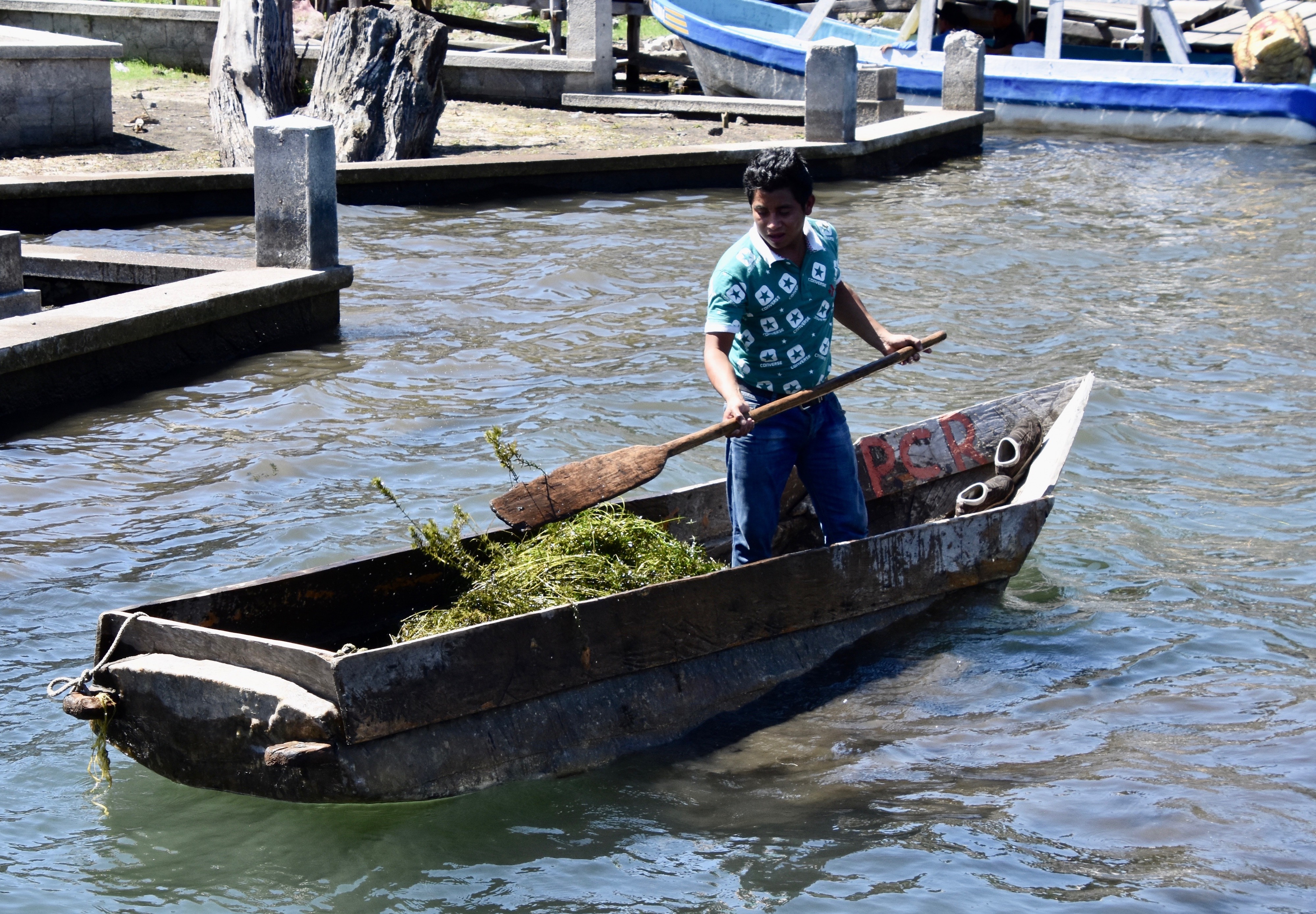
Santiago Atitlan
Getting out, Victor and our Guatemalan guide Tony commandeer a fleet of tuk-tuks and we are soon whisked through the crowded streets of this bustling town to the central plaza.

Santiago Atitlan is home to yet another Mayan subgroup, the Tz’utujil people who once controlled much of Lake Atitlan until the Spaniards arrived. Today, aside from Panajachel, most of the villages around the lake are populated by Tz’utujil Mayans who, collectively, number only about 100,000 and have a syncretic form of religion which is absolutely fascinating.
As most people know, Santiago is the Spanish equivalent of St. James and this rather unprepossessing looking church is, in English, Saint James the Apostle Church. It dates all the way back to the 1540’s and lies in the shadow of the mighty Atitlan volcano which rises to 11,598 feet (3,535 metres) which in the Rockies would be a good sized mountain. The steps you see are actually over a thousand years old and once led to a Mayan temple which the Christians of course destroyed to build the church atop in an act of religious oneupmanship. But it didn’t actually work as we shall see as we enter what is one of the most fascinating churches I’ve ever visited anywhere.
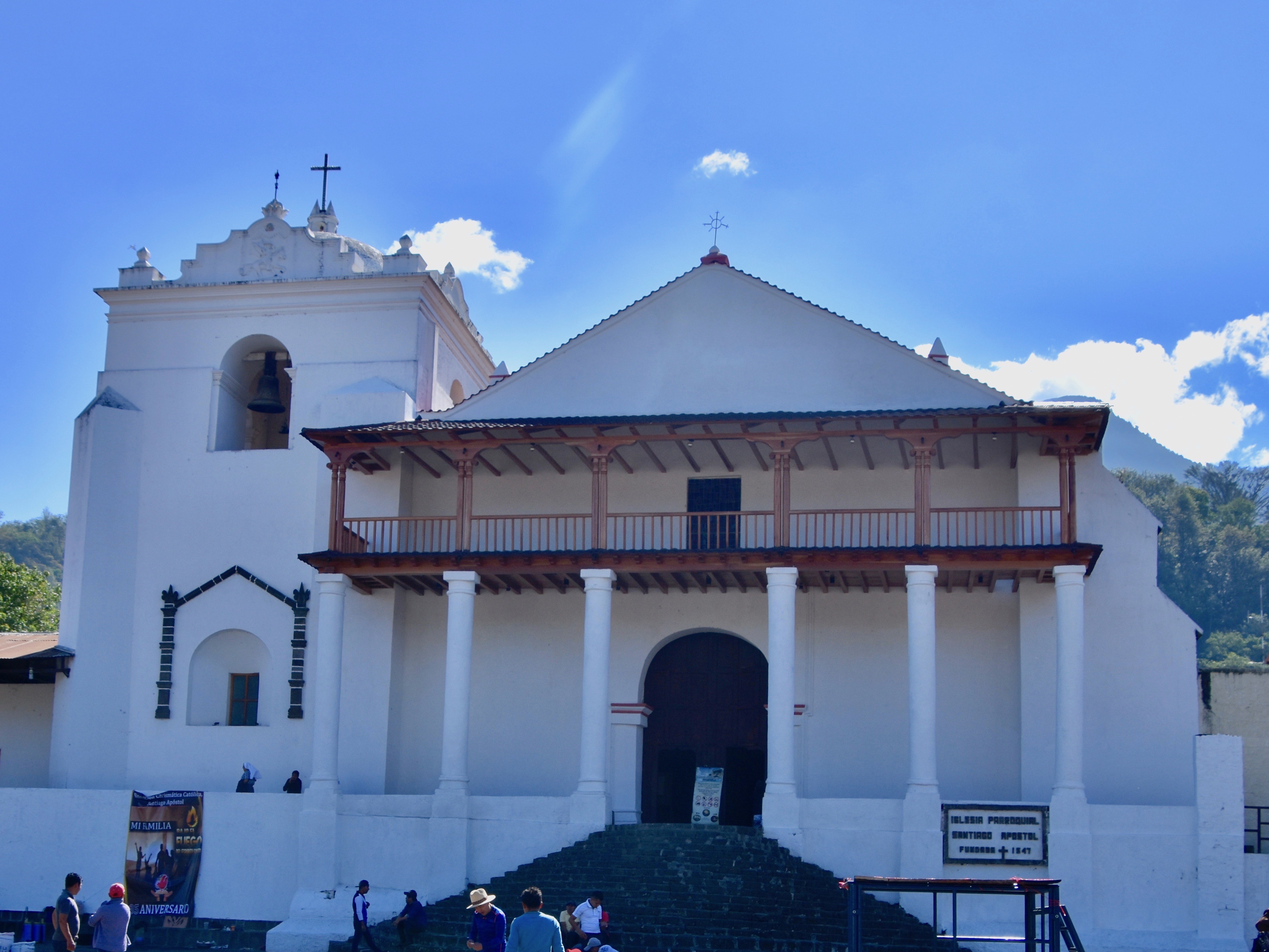
Tony takes us on a guided tour of the interior which has more than a few things of passing interest starting with the various saints decorated by groups that are unique to Guatemala, the cofradias. These are religious brotherhoods that date back to the Spanish conquest and were originally intended to help spread Catholicism and stamp out native beliefs. Instead they have morphed into something similar to the krewes of Louisiana who each have their own distinct colours and symbols. The entire church is lined with these brightly coloured figures. The guy in the brown outfit looks like he’s pulling a move right out of Saturday Night Fever.

These are the boys in red. Note the bright ties on two of them.
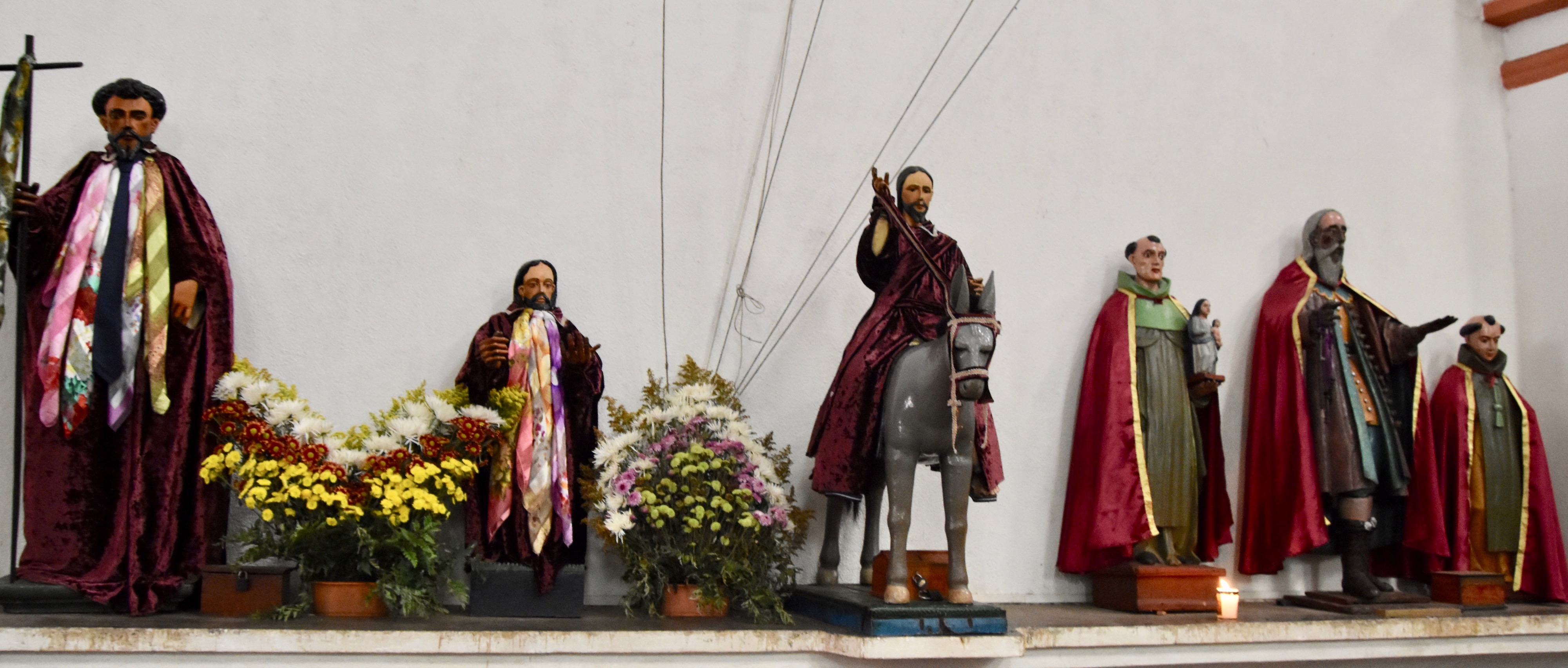
Sometimes things are not as they first seem to appear. This is the pink cofradia.
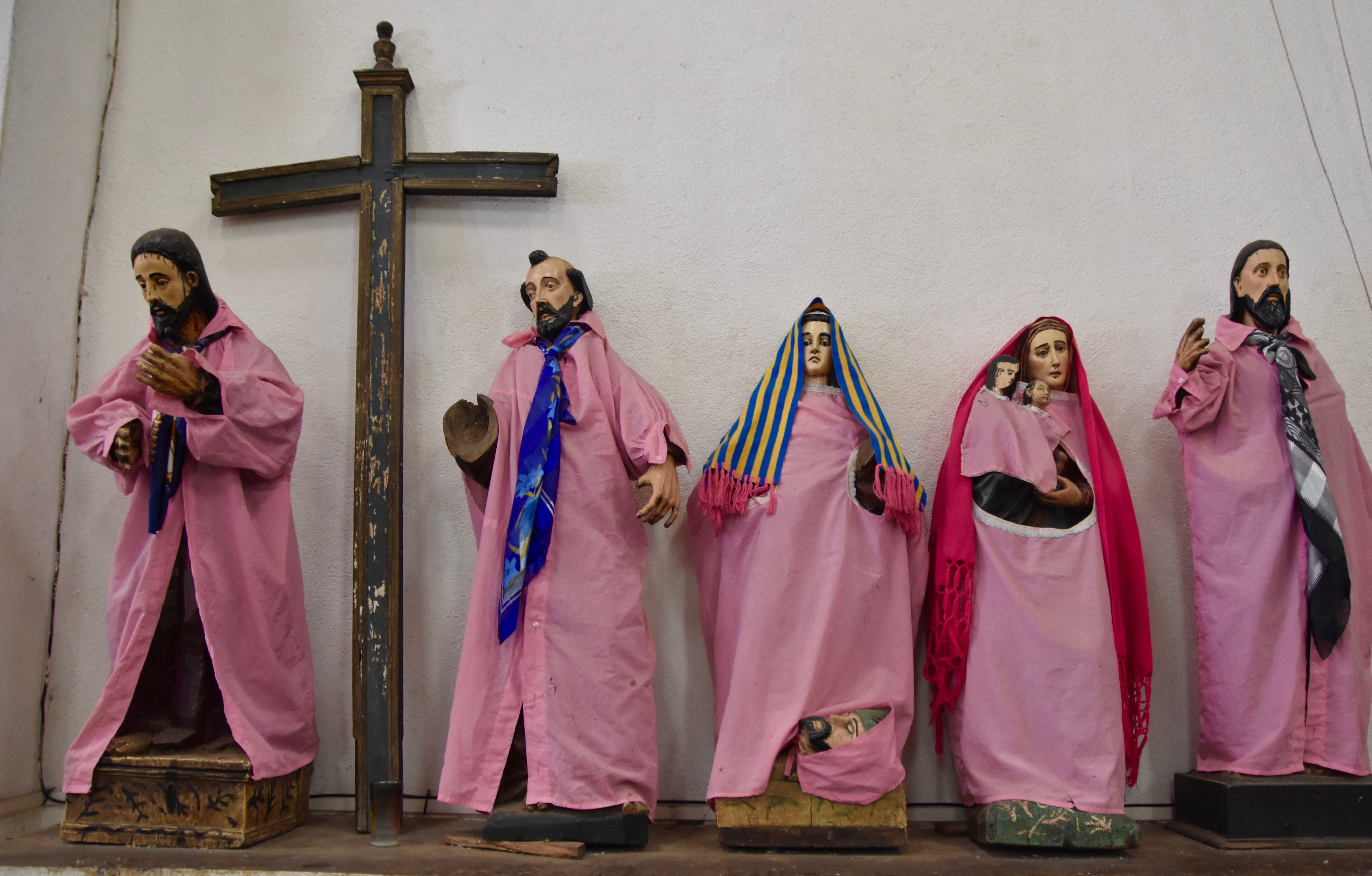
But take a closer look at the Virgin Mary. WTF? She’s got two babies, not just the usual one. Here’s where things get tricky and try as I might, I can find no one coherent explanation for the two babies. Here is Tony’s version. The second baby is actually Judas. Yes, you read that right. For Mayans, the death of their religion at the hands of the Spanish priests was not cause for celebration or a great awakening, but rather an execration. The one figure from Christianity that many of them could embrace was Judas who was responsible for getting Christ killed and thus in their eyes, more powerful than Jesus. There are umpteen versions of the story and we shall see more even before we leave Santiago Atitlan, but let’s finish exploring the church first.
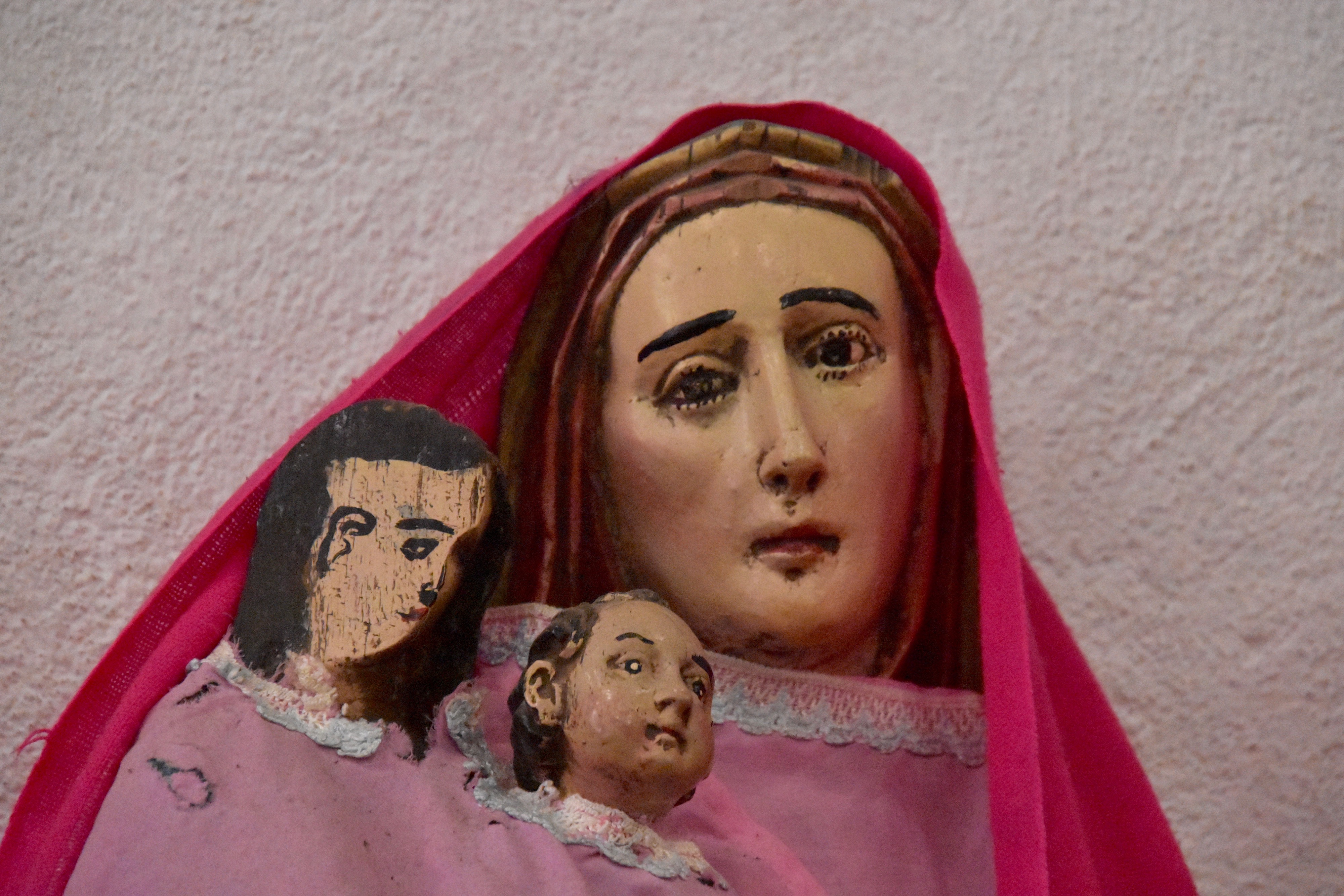
This is a group I call the blue krewe.
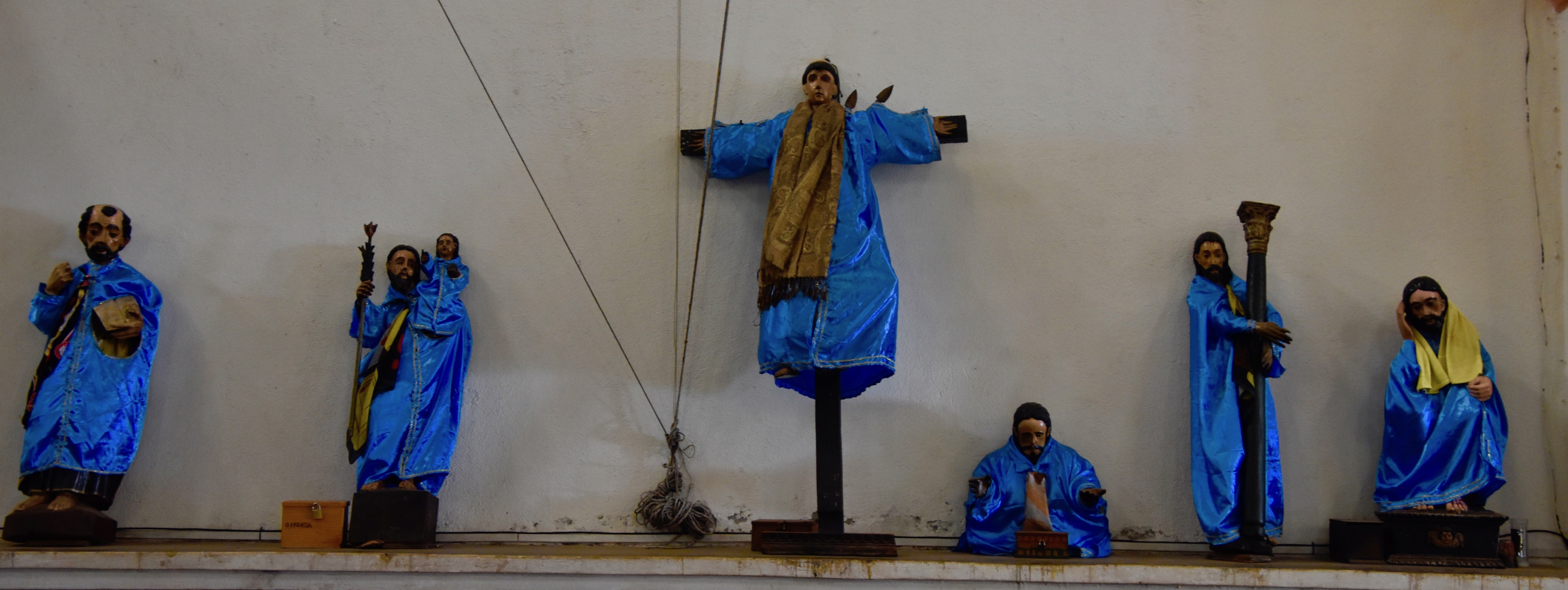
The altar of the church is fairly standard, but what’s behind it is not.
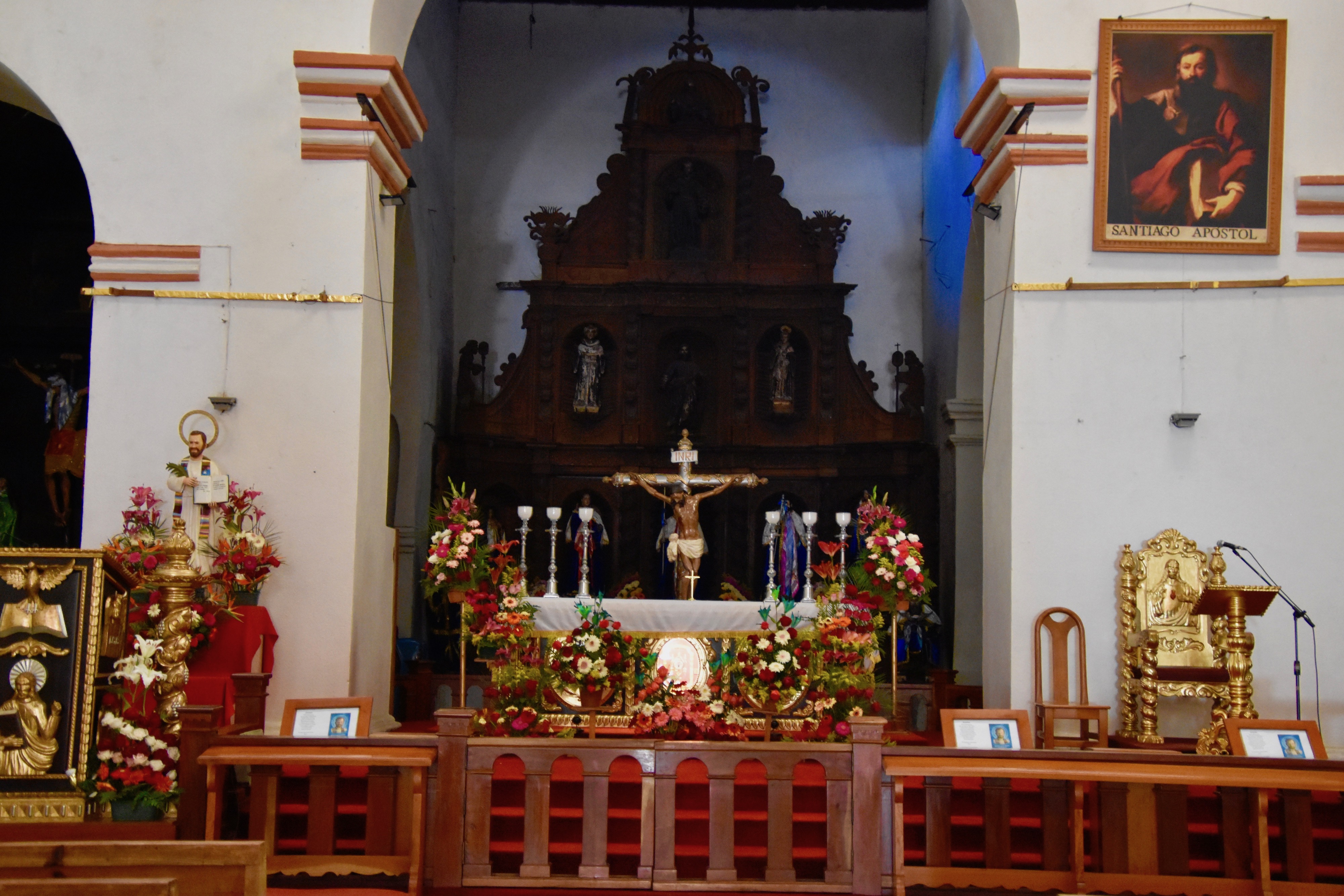
This is the apse with this wonderful carved wooden panel with ten figures adorning it (twelve if you count the two wooden ones at each end at the top).
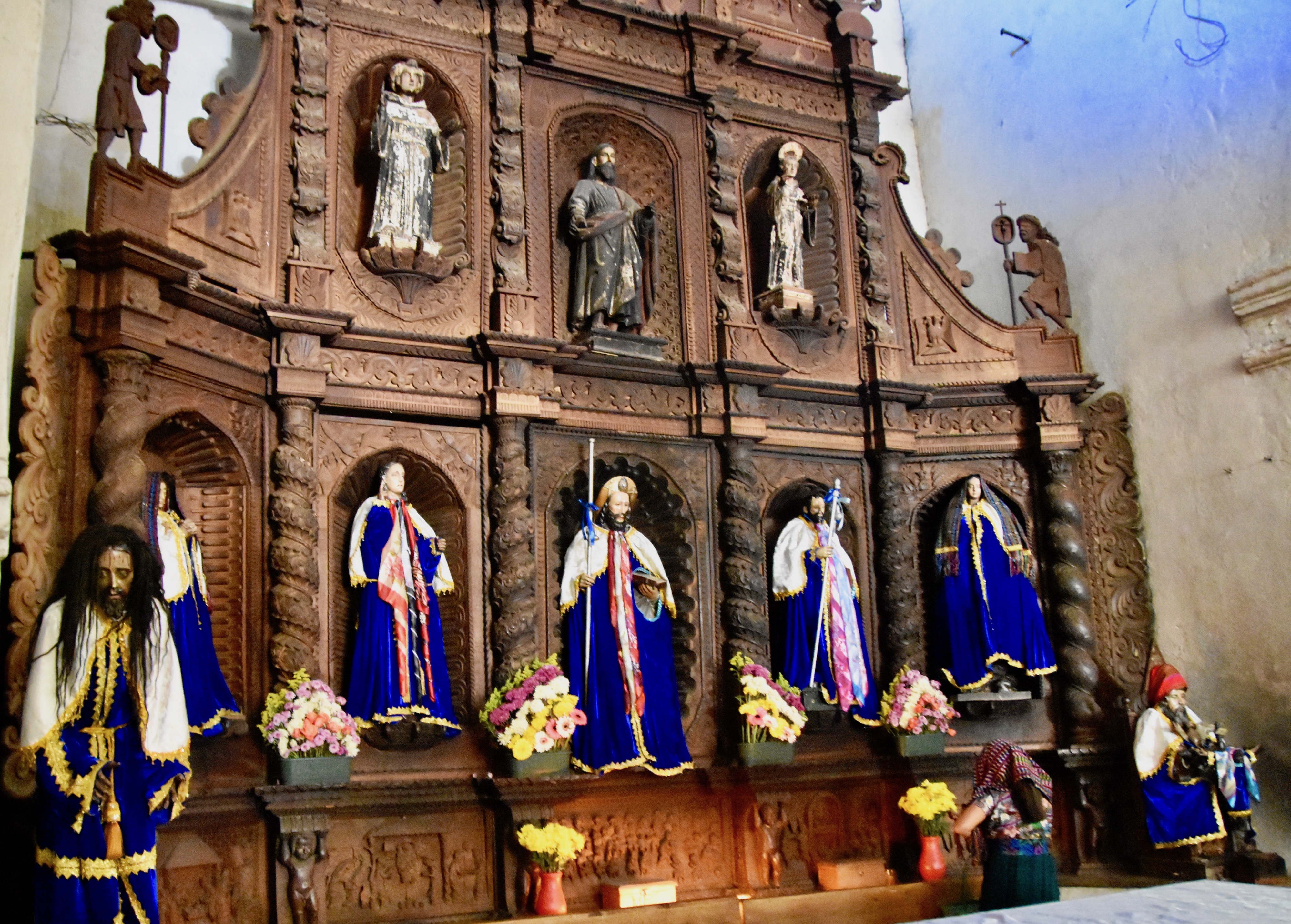
A closer look reveals this ghastly looking version of Jesus who, uncharacteristically is shunted off to the side while lesser figures occupy centre stage.

Opposite Jesus on the other side, is this rendition of the Holy Trinity, but when I first looked at it, I thought it was an old guy in one of those euphemistically named ‘motorized mobility scooters’ that you increasingly see tearing up and down the sidewalks of North American cities.
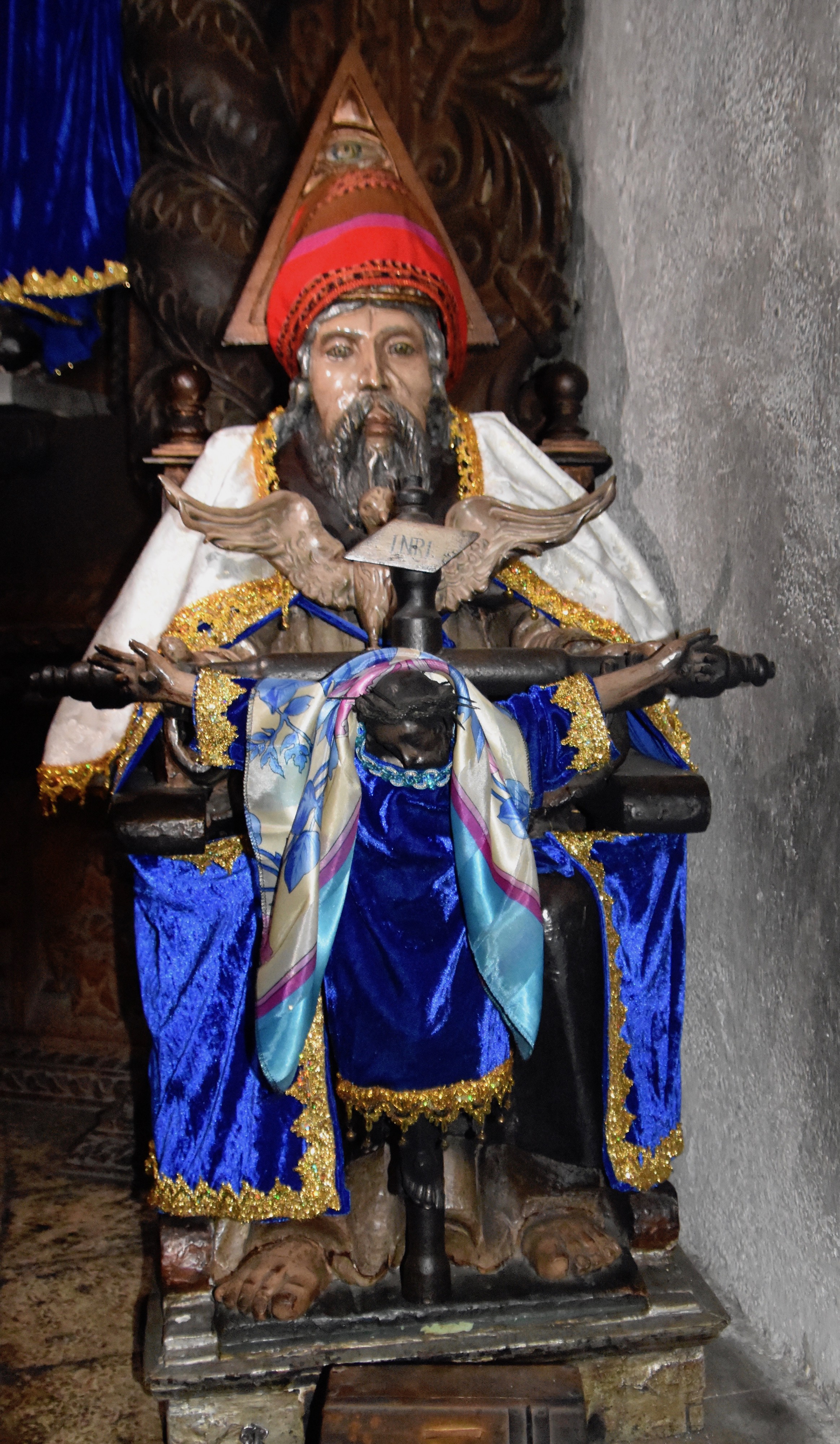
One a more serious note, there is an important monument near the church entrance that is worth examining and learning the story of Father Stanley Rother. He was an American priest who came to Santiago Atitlan and during the civil war, defied the authorities and stood up for the Mayan people that were frequently the target of massacres during this time. For that, he paid with his life and has been recognized as a genuine martyr in every sense of the that word.
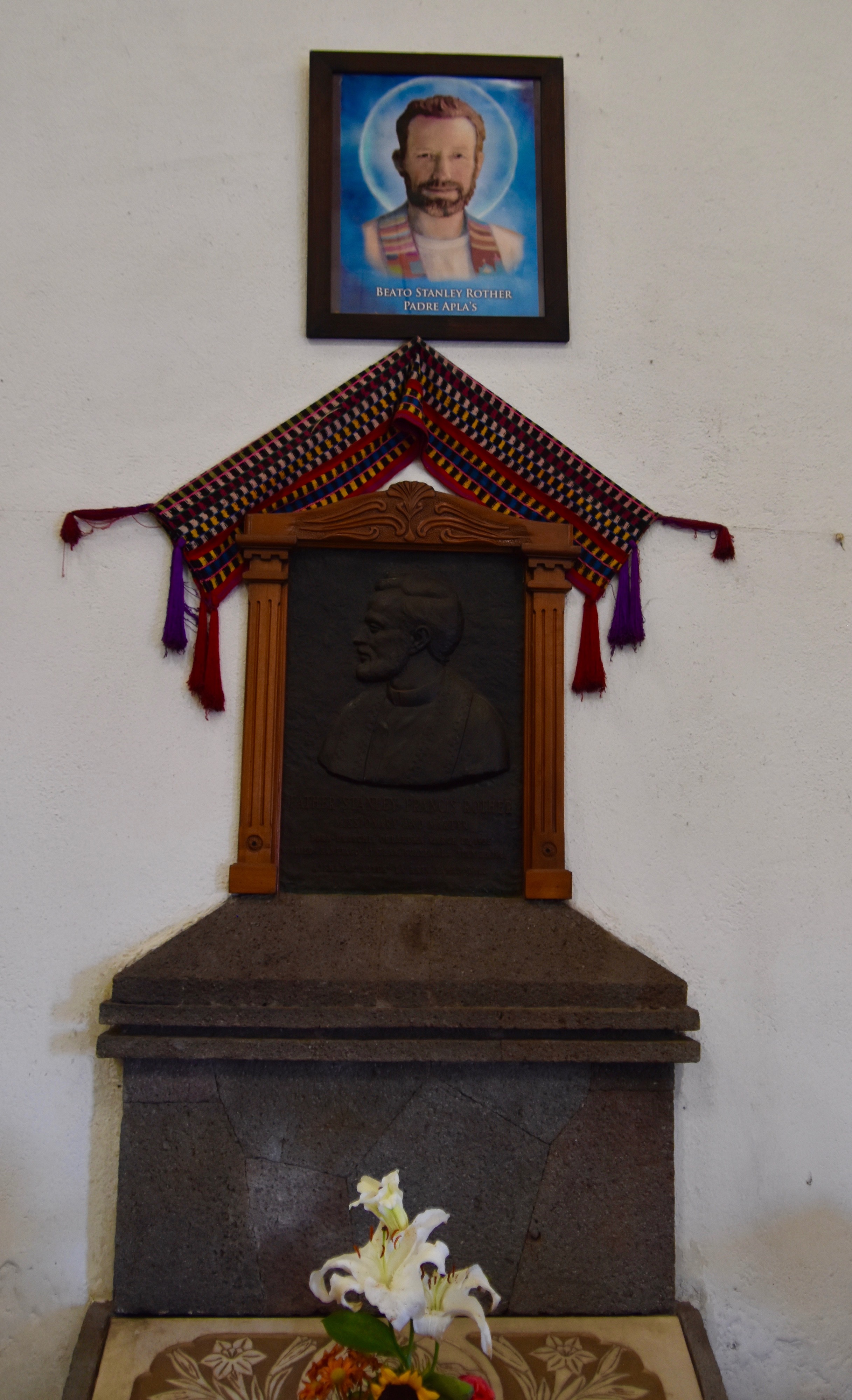
Although his body is buried in his native state of Oklahoma, Stanley Rother’s heart is buried here and that seems appropriate because he gave his heart and his life to the Tz’ujutil people. While I might not agree with religious proselytizing, no one can dispute the goodness of this man’s intentions to help the poor and downtrodden. In this world where Catholic priests are just as often seen as predators rather than protectors, it is comforting to know that that some truly follow the true teachings and example of Jesus, even if it costs them their lives.
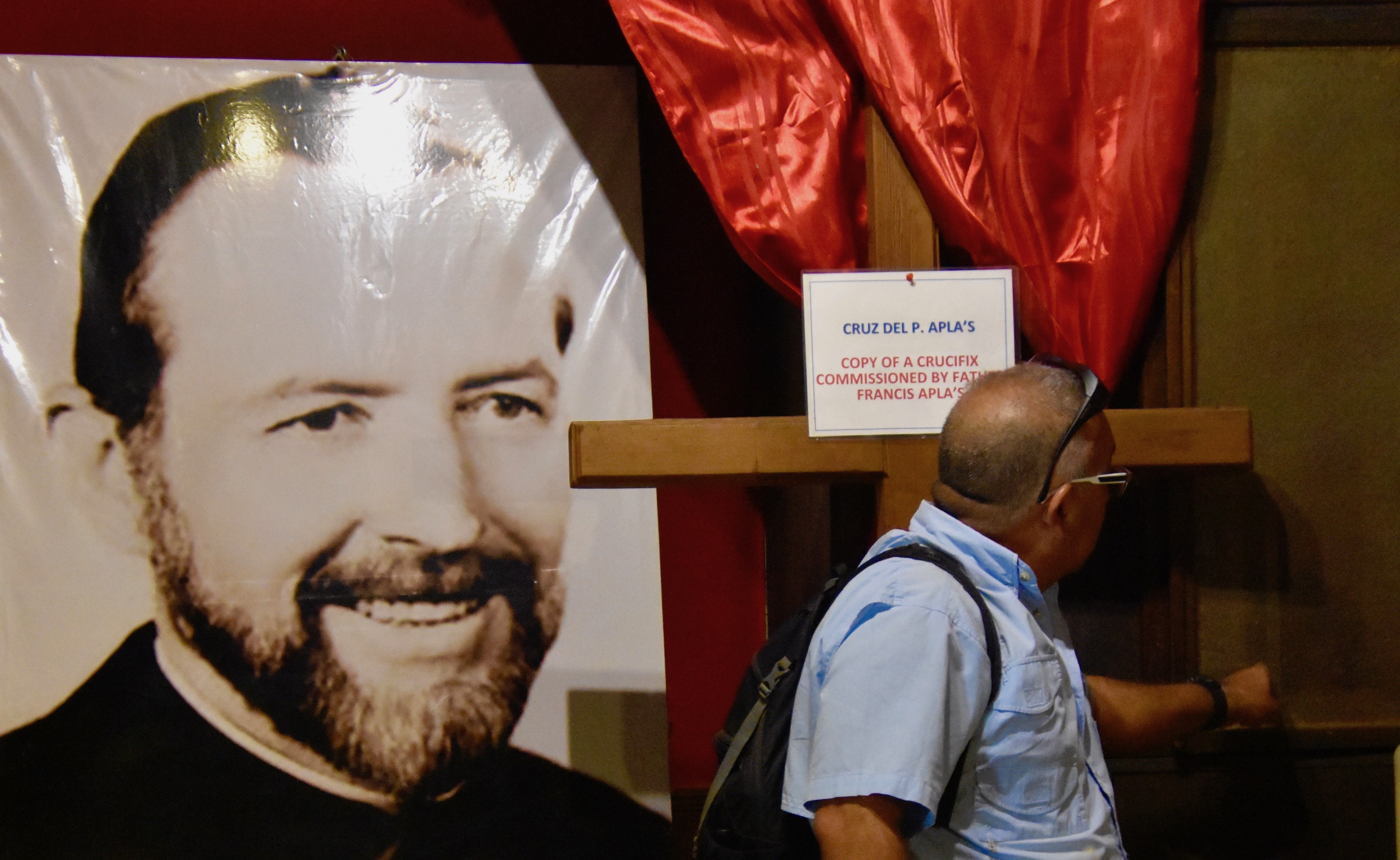
Beside the church is the rectory and Tony points out the very spot where Rother was murdered by a government backed death squad in 1981. Sadly that was not the end of the violence. In 1990, eleven more people were killed in Santiago Atitlan by the army which had a base nearby. That event caused such an international uproar that the base was closed and since then life in this small place has returned to a semblance of normalcy.
Leaving the church area we are headed for the market, but not before Tony stops to talk to a tiny, wizened old lady. He explains that in her youth she was a famed beauty and you can certainly see it in her face. Alison posed for a photo with her. She also demonstrated how the Tz’ujutil women create a bonnet out of what appeared to be just a long cloth band, whipping it around head to create what she is wearing in this photo.
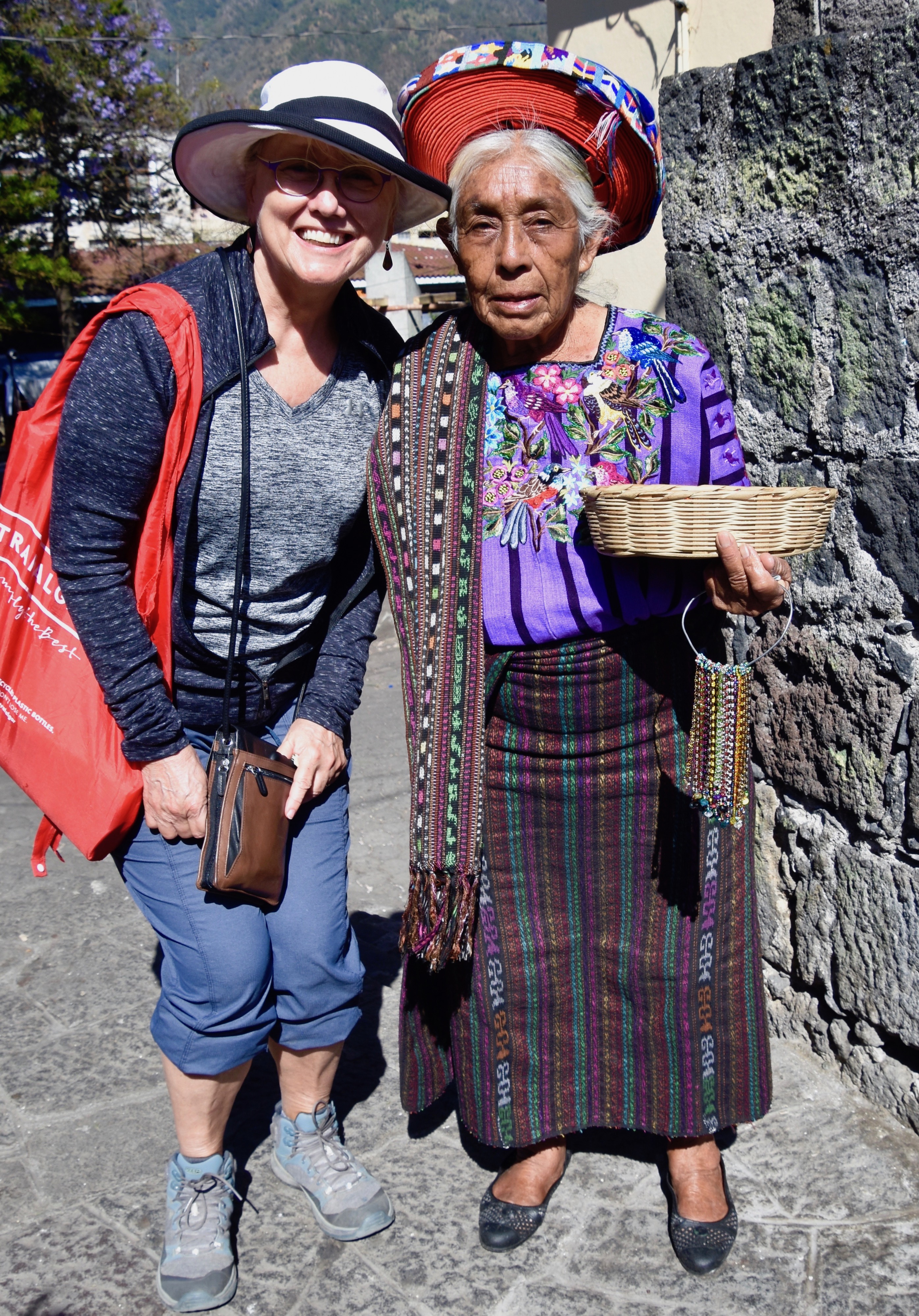
Rounding the corner we saw her face again, although many years younger. She was the model for the image on the Guatemalan 24 centavo coin and the residents of Santiago Atitlan erected this monument in her honour. Who says you don’t meet famous people on Adventures Abroad tours?
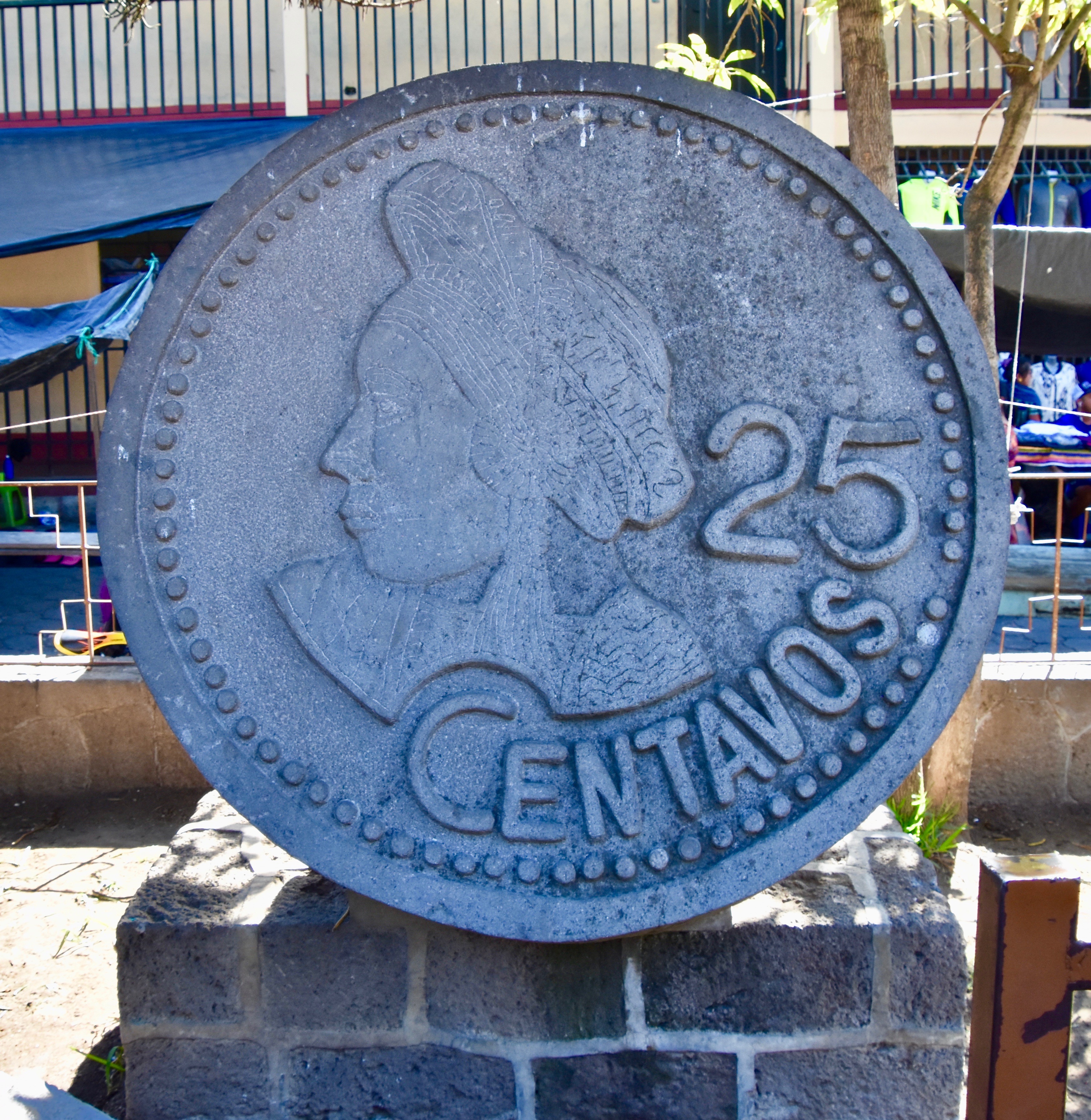
In my previous post I wrote about the wonderful market at Chichicastenango and perhaps was expecting more of the same here. In some senses the market was similar, certainly in terms of the bright colours of the textiles. The patterns of the Tz’ujutil Mayans were completely different than the K’iche’, with flowers and birds being the predominant themes, rather than geometric patterns. Many of them would qualify as works of art and no two were alike.
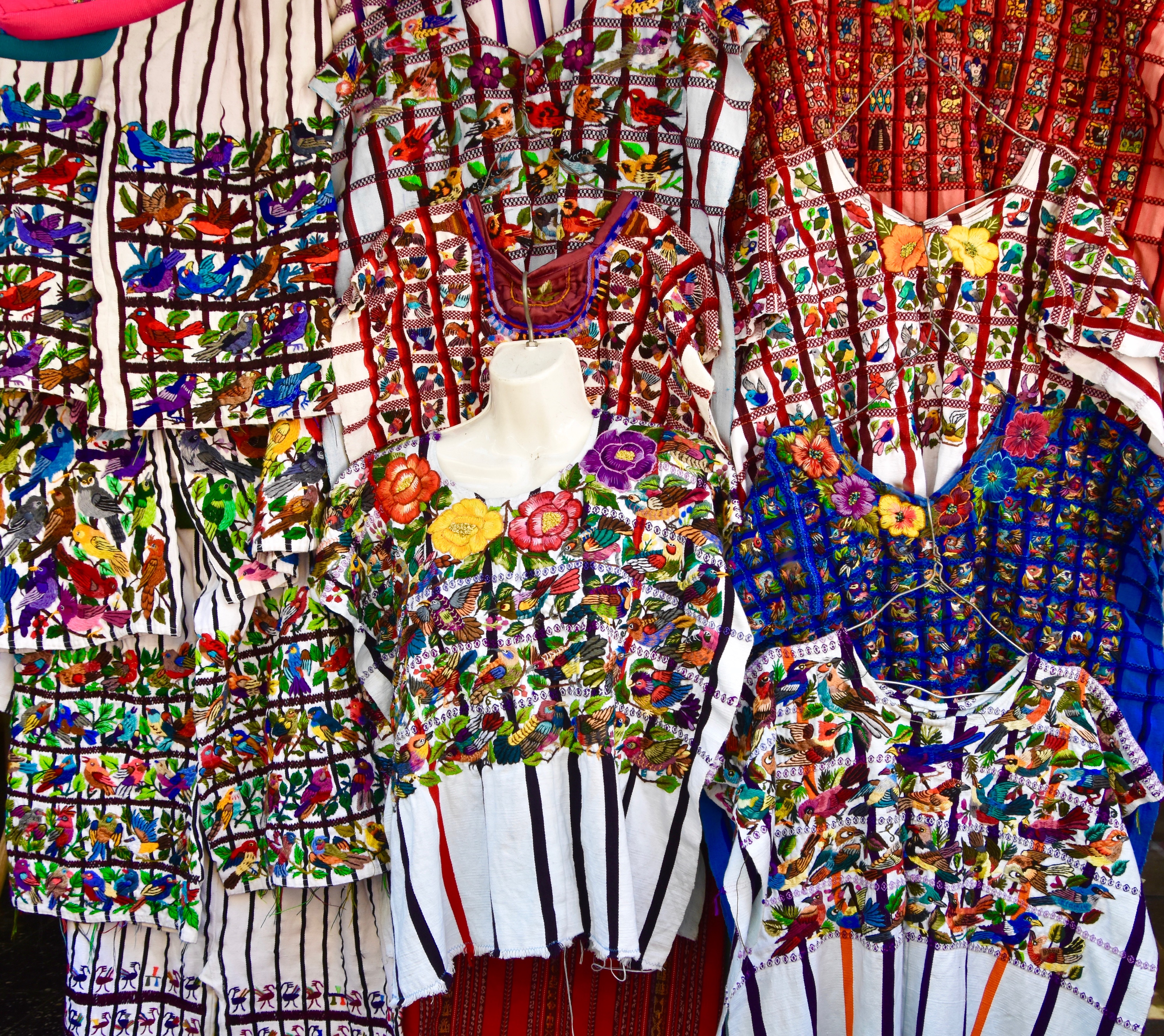
What was different at the Santiago Atitlan market was the absolute chaos of the place. The people were jammed in so tight that we literally had to squeeze our way through in many places. Here you can see Alison, at five foot four, towering over most of other market goers. Considering that some in our group came in at well above six feet, it was an unusual sight to say the least to see our stream of putative giants slicing through the Lilliputian crowd. Oh, and social distancing? Forget about it.
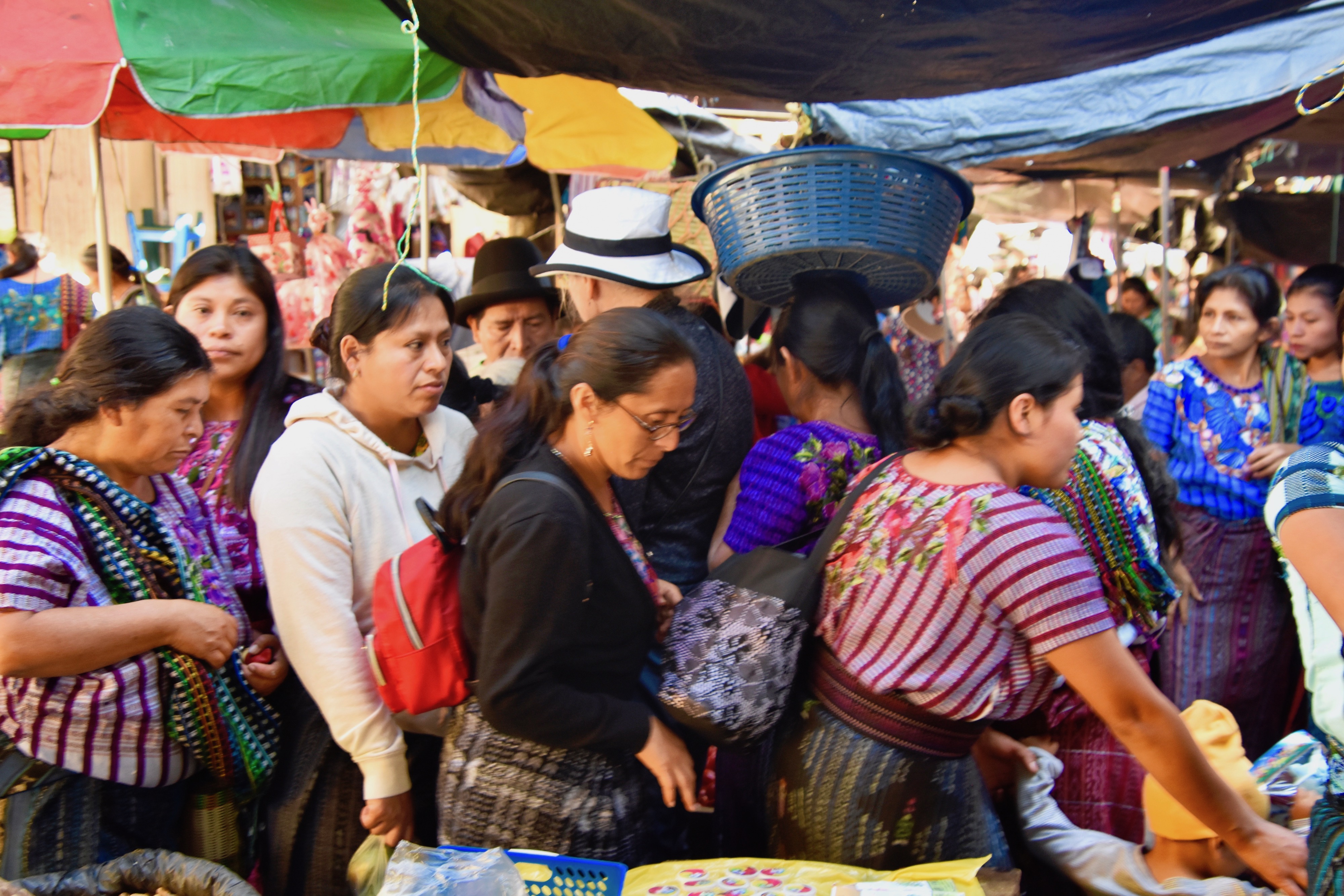
Flowers seemed especially important to the Tz’ujutil people as at least half of the people at the market were either buying or selling.
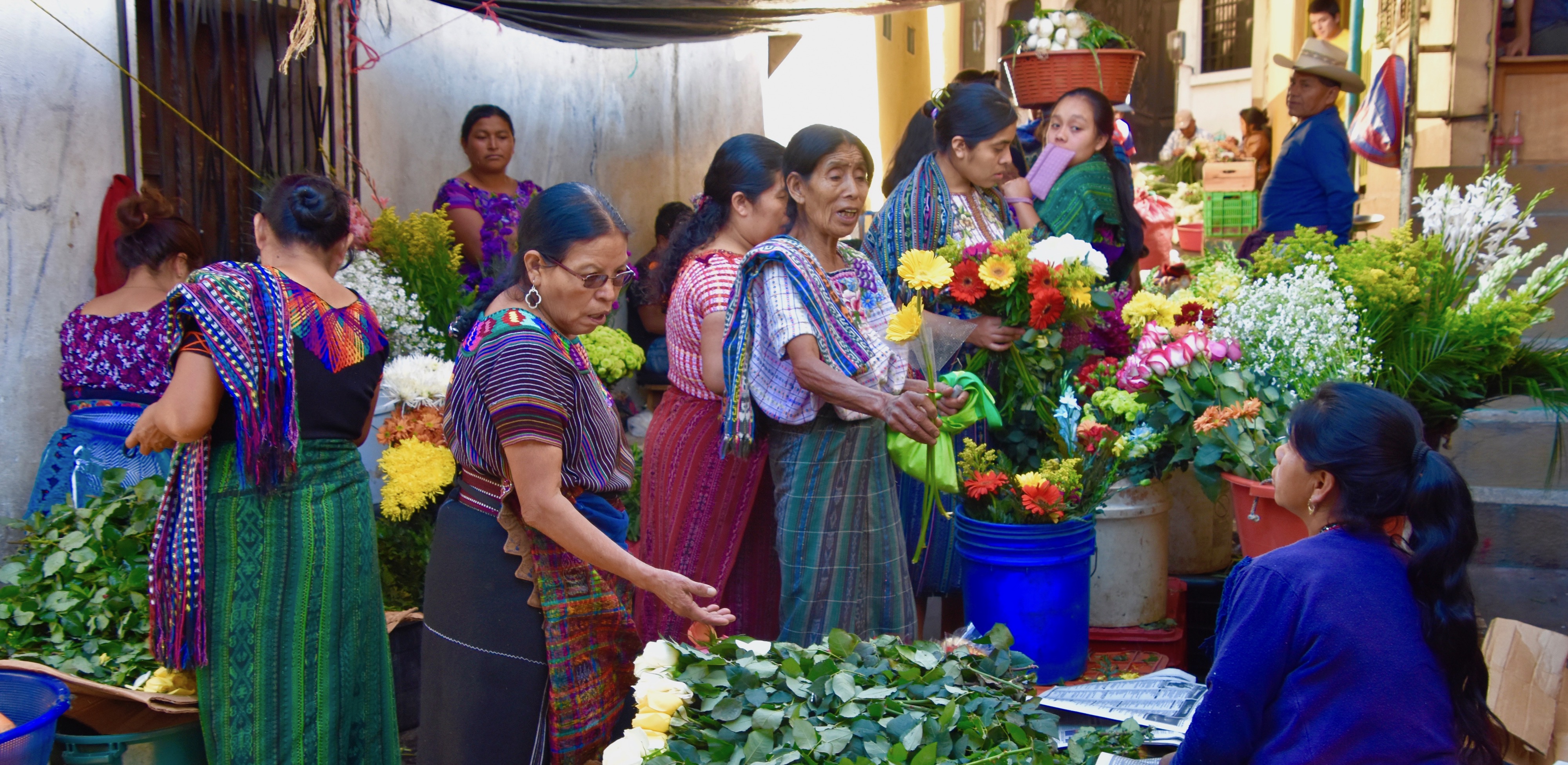
I’m not a big fan of crowds so I was not disappointed to get out of this particular market and follow Tony through a series of narrow streets to find something that moves around from house to house in Santiago Atitlan.
Maximón
Perhaps the ultimate in religious syncretism is the cult of Maximón or San Simon who is described in this National Geographic story as the ‘Liquor-Drinking, Chain-Smoking Saint’. Although, like the association of Judas with Mayan Catholicism, there are many versions of just who this guy is and how he came about, all agree that he constitutes the embodiment of a Mayan god or character with a Christian saint. He has both good and bad traits like most of the ‘trickster’ characters found throughout the world. In Santiago Atitlan he is a carved wooden figure that was allegedly created by shamans to protect the town, which after a bad start which required his head to be twisted around and his legs broken, has been working pretty well ever since. He must not have been on duty when Father Rother was murdered or during the 1990 massacre.
Anyway, Maximón belongs to the town and every year is moved to a different location in the charge of a different cofradia. Tony knows where he’s holed up this year and we enter a small courtyard where a number of people are standing around and these young boys looking ever so nonchalant.
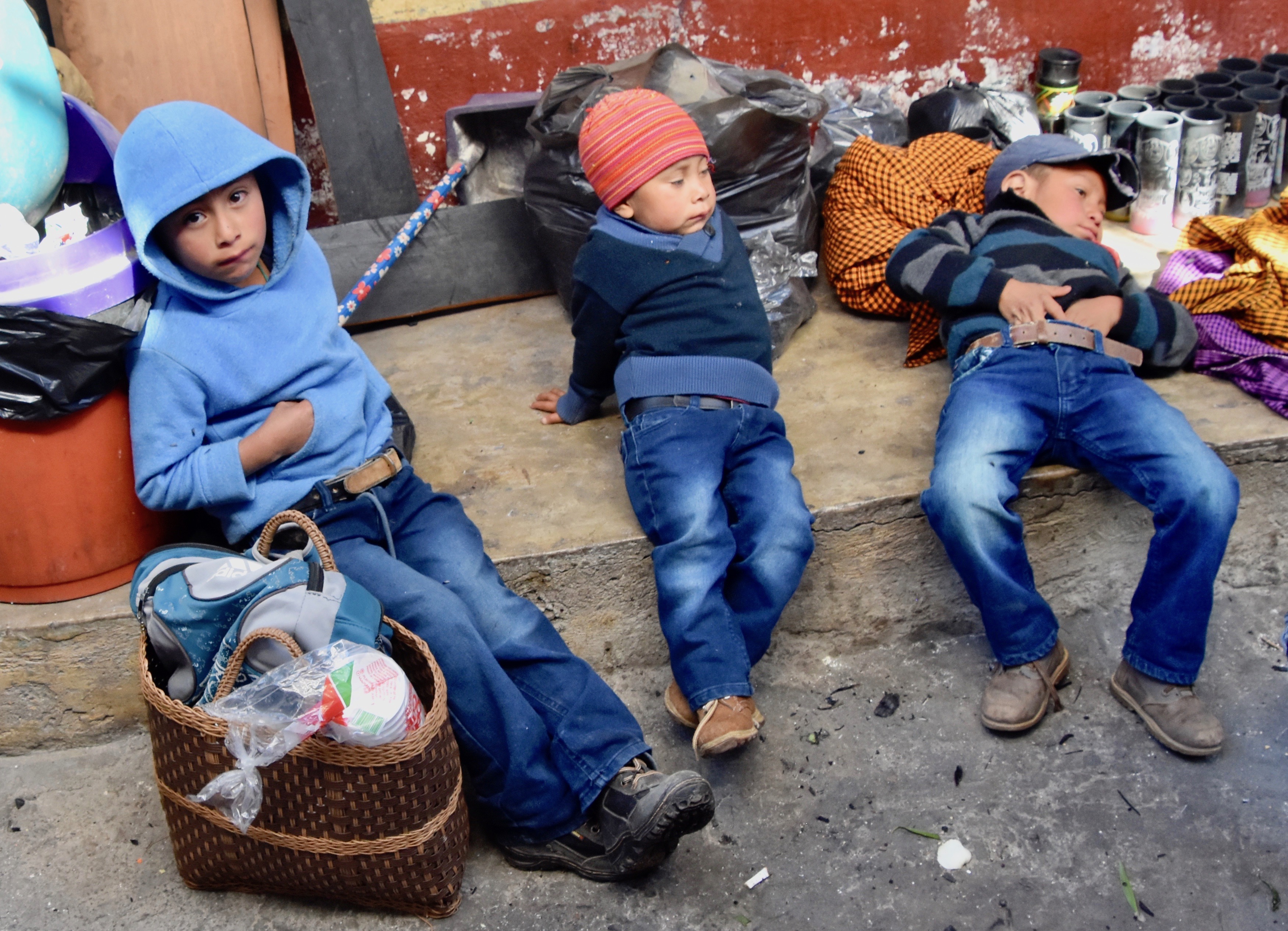
This is a Mayan shaman leading some type of ceremony. Maximón is inside a small room which she is looking into as she intones.
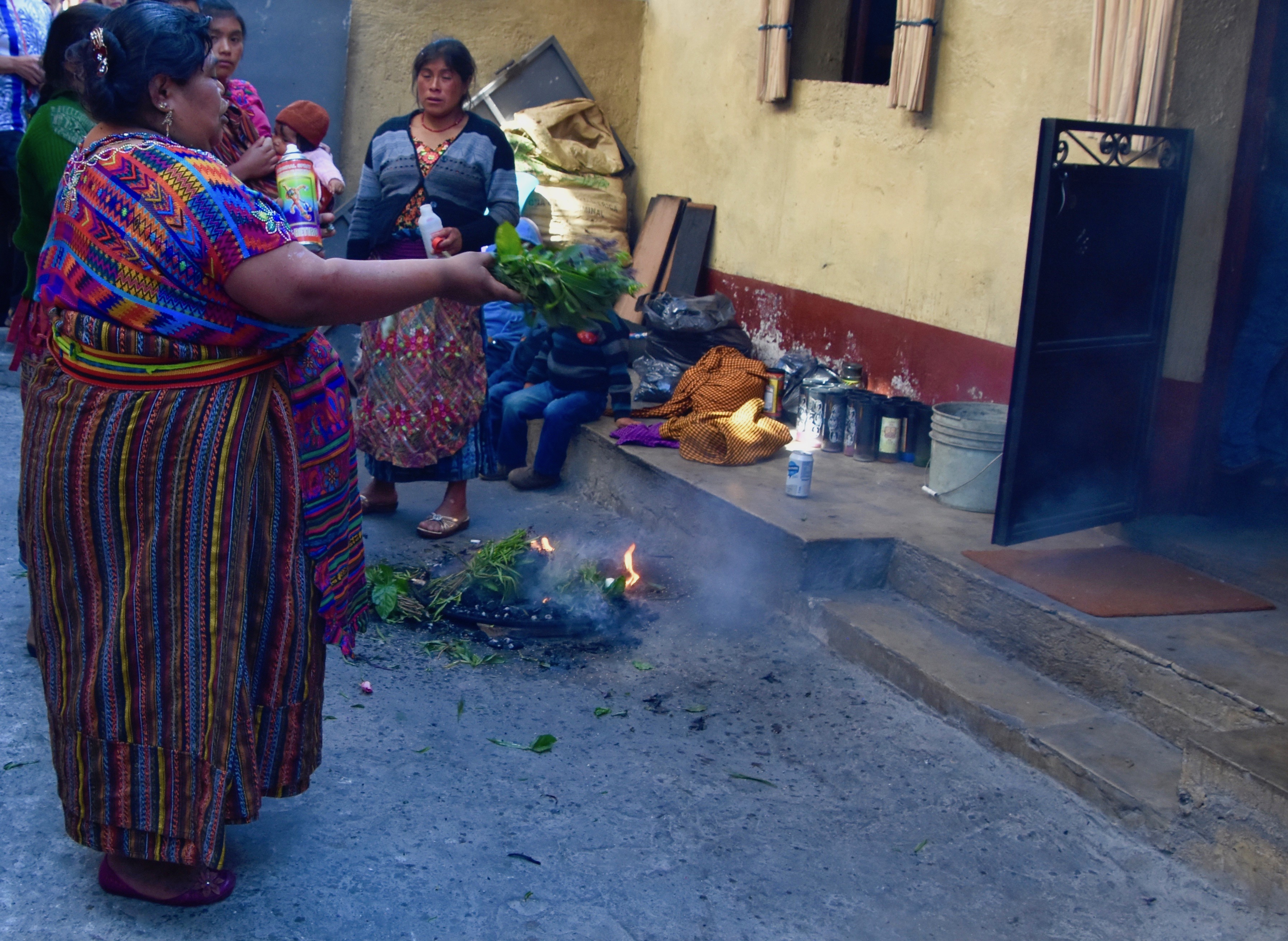
After paying the obligatory offering, i.e. cash, to Maximón’s handlers we are permitted inside, one by one, for a quick glimpse of the legendary figure himself. Look closely and you’ll see the bills underneath his tie. How do you say ‘racket’ in Tz’ujutil?
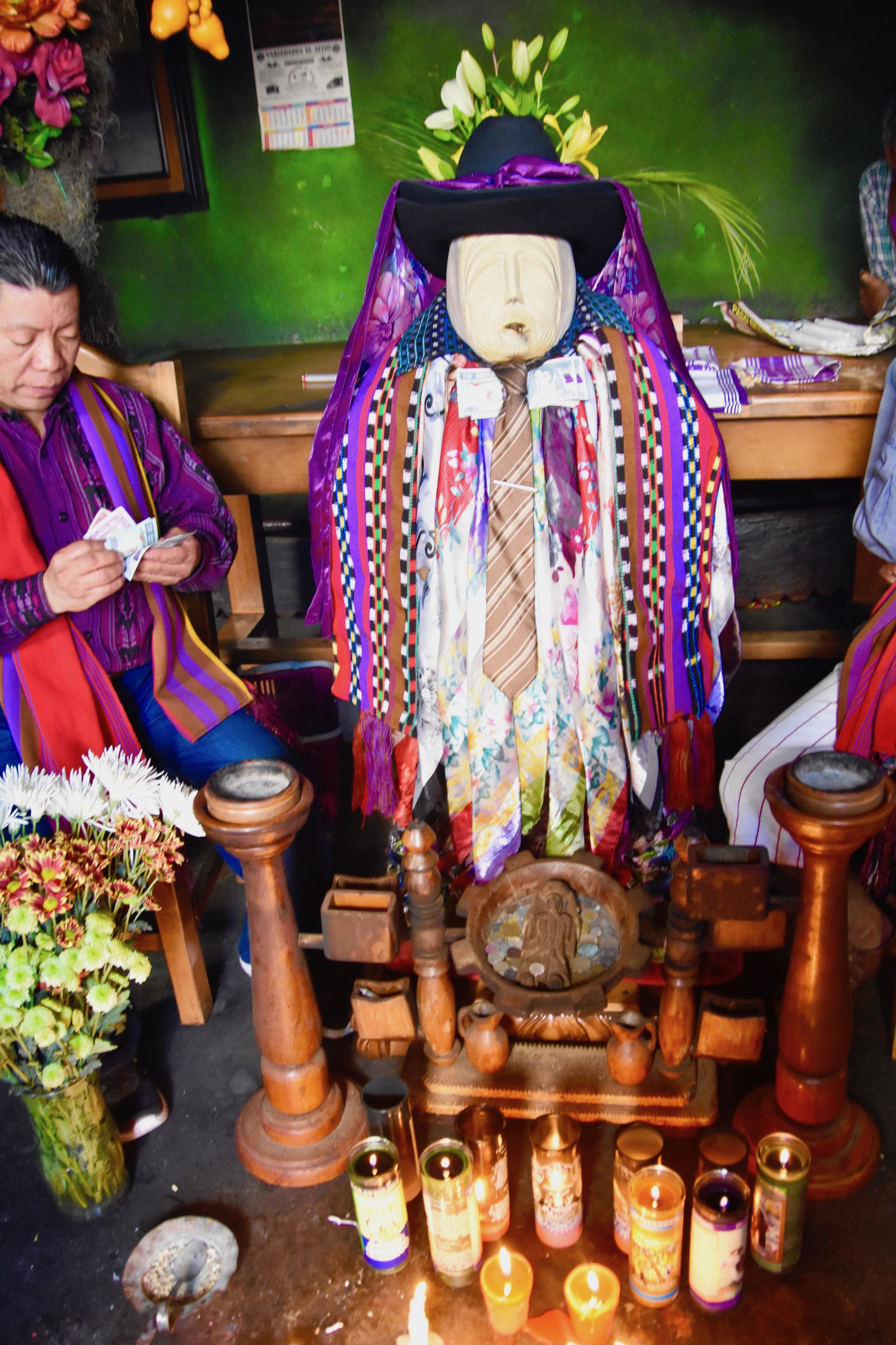
No matter what you might think of Maximón and his followers, this is fascinating stuff and one of the great reasons why travel is, for me, an absolute necessity, just like liquor and cigars are for him.
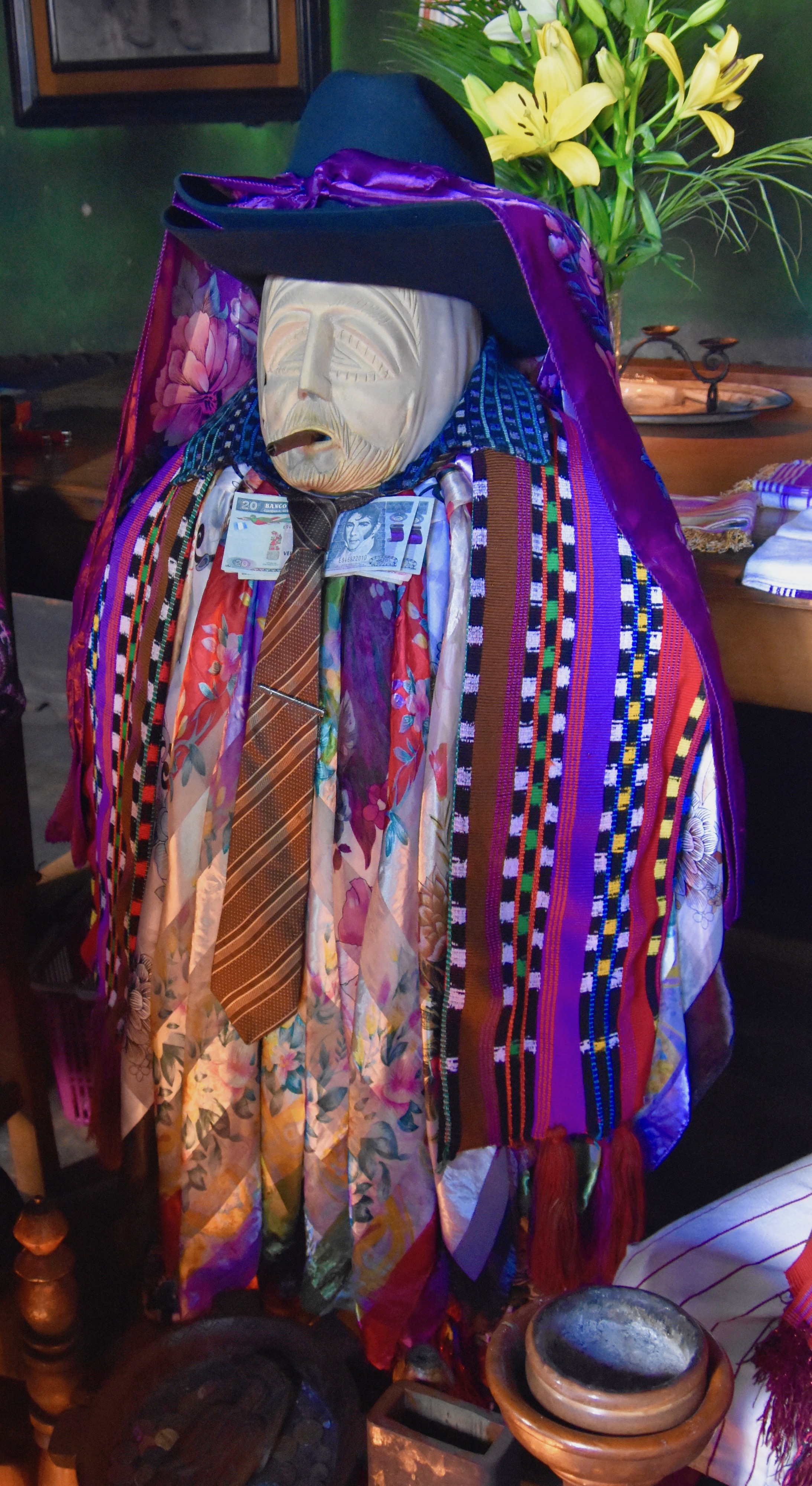
The one thing I really did not like about Santiago Atitlan was the persistence of the trinket sellers in and around the main street leading up from the waterfront. They were very young and as annoying as the gadflies Hera would send to torment Zeus’s mistresses. They had every trick in the book, ultimately playing the guilt card which really pisses me off. The reason it stood out was that it was the only place in all of Central America that we ran into this type of ultra aggressive hucksterism.
Back on the boat we were headed to a much smaller town on the Lake Atitlan lakefront.
San Juan La Laguna
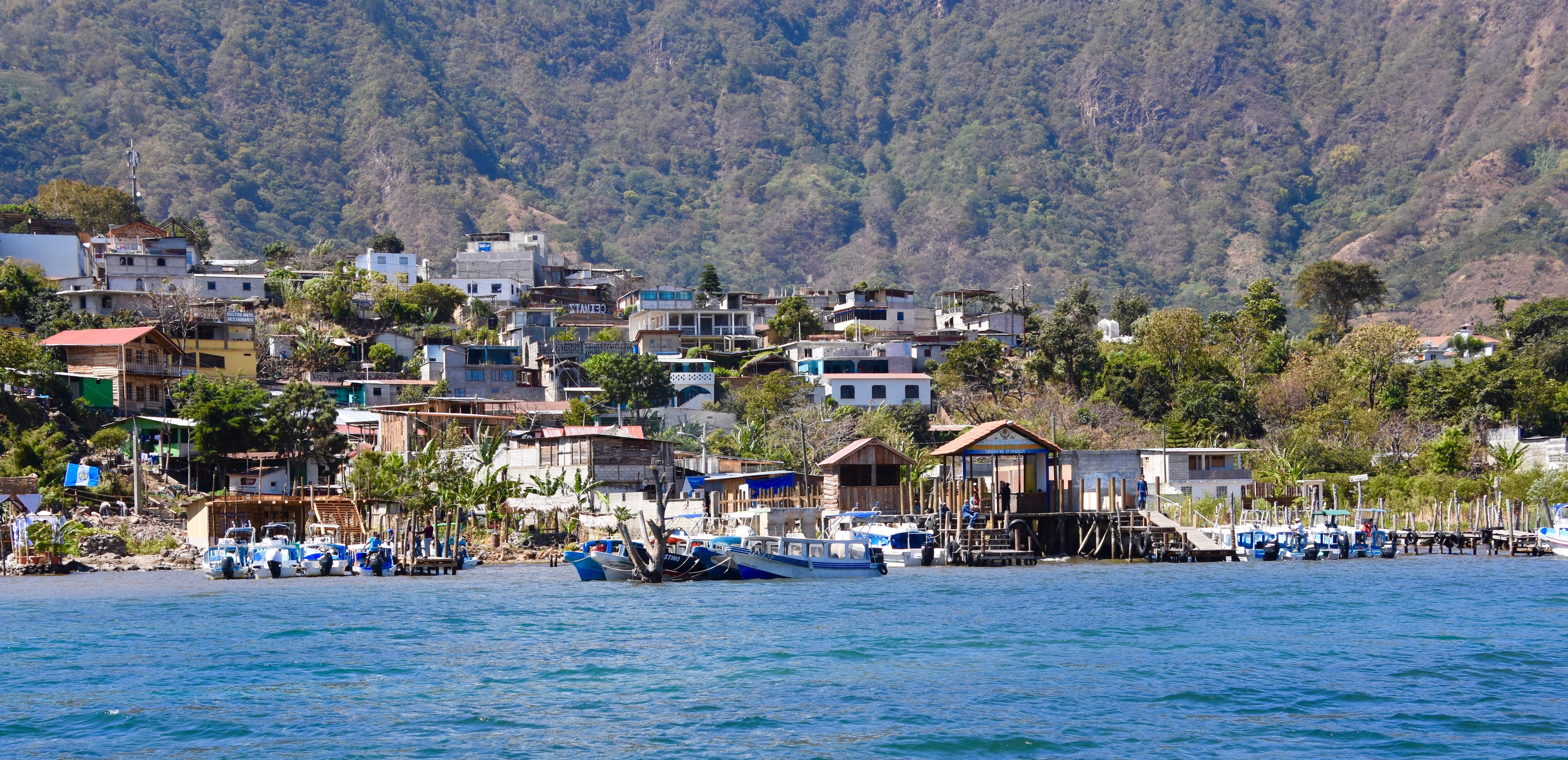
About a twenty minute ride from Santiago Atitlan is the much smaller town of San Juan La Laguna which seems to consist of one main street leading up from the waterfront to the plaza where the church is found. Along the way are a great number of handicraft shops, coffee and chocolate emporiums and a number of attractive murals. It’s an interesting place that actually seemed to have more tourists walking about than Santiago Atitlan.
Pulling up to the dock I noted this hard working man and his relaxed looking dog.
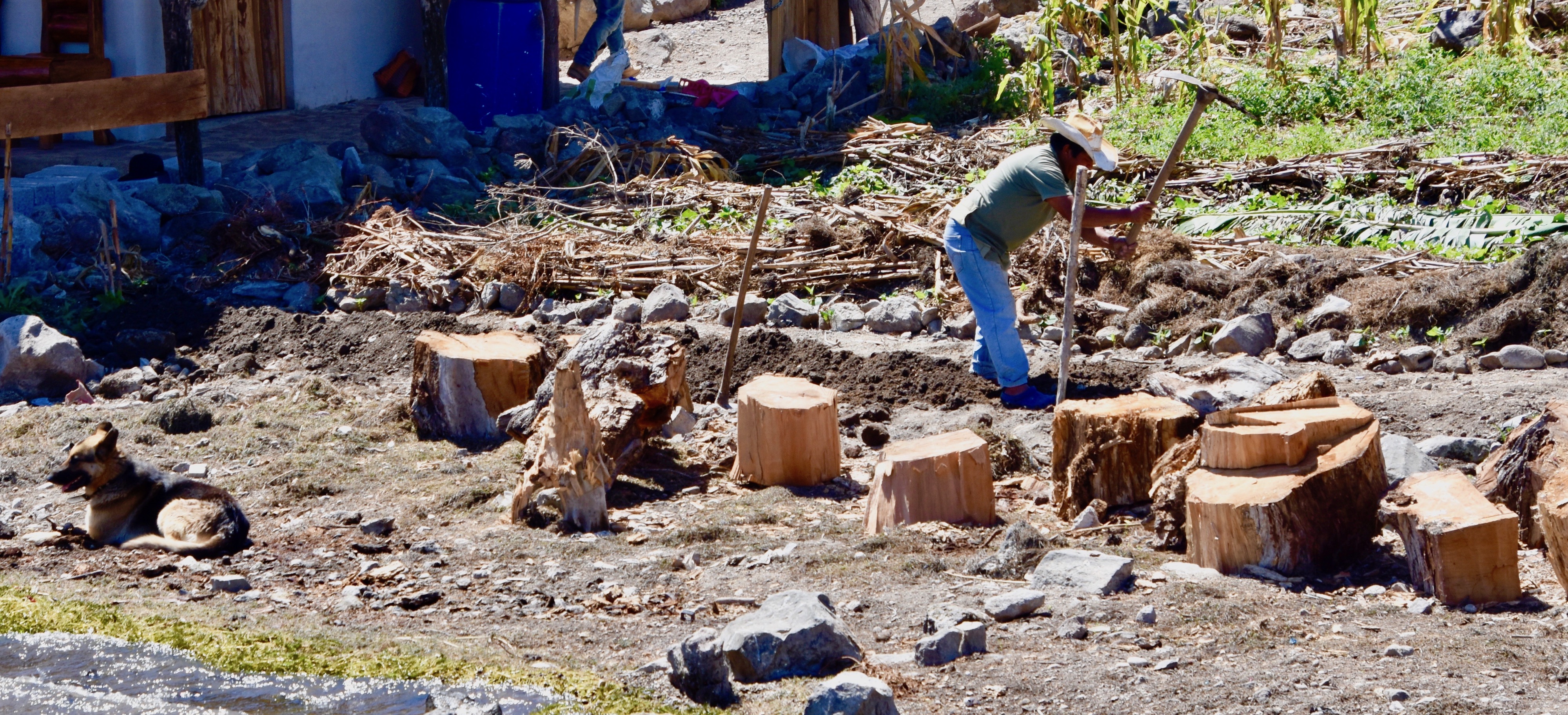
This is the main street. Looking at this photo now I don’t see any people wandering about, seeming to contradict what I just wrote about the number of tourists, but I assure you they are there, just hiding for some reason.
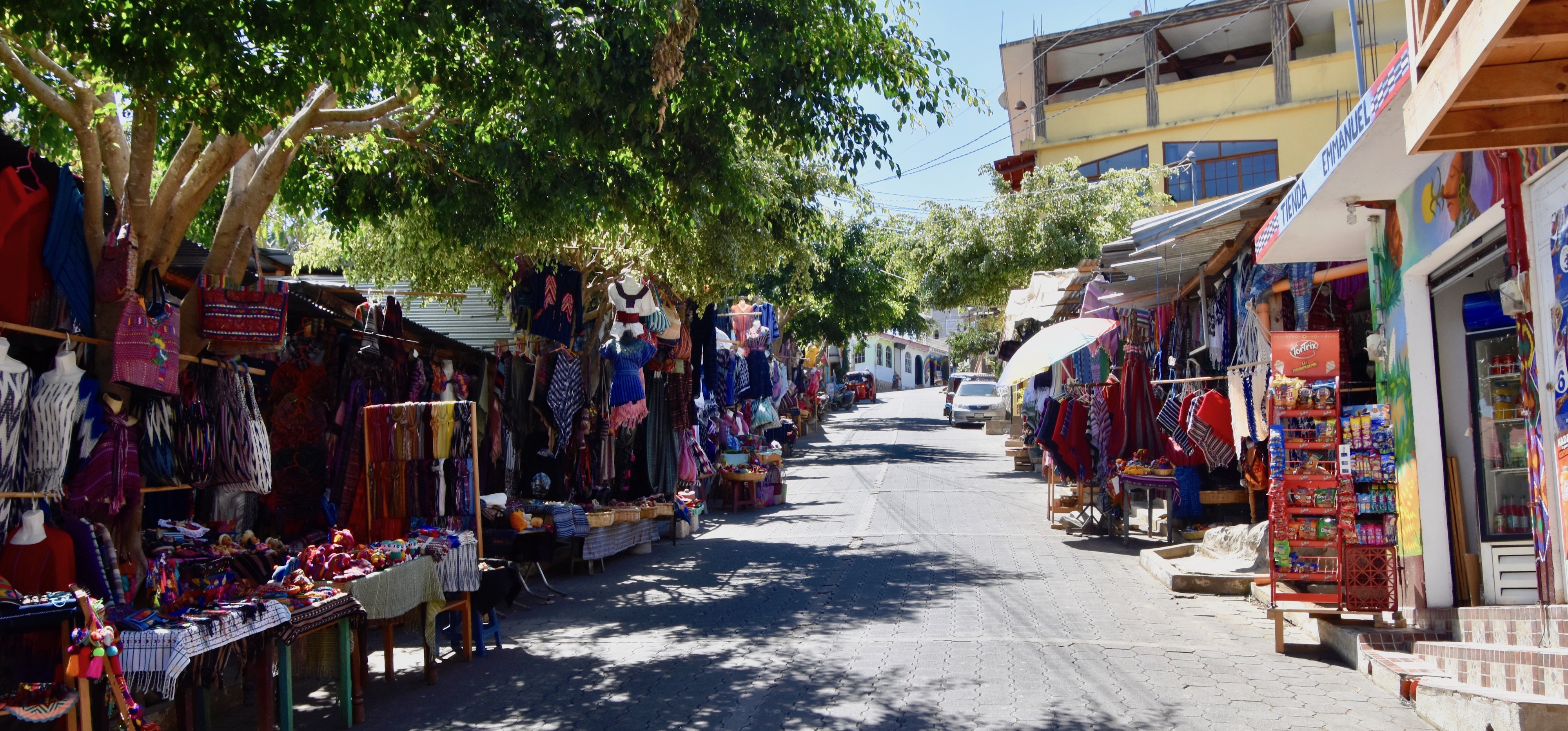
A few examples of the murals you’ll find as you make your way up to the church.
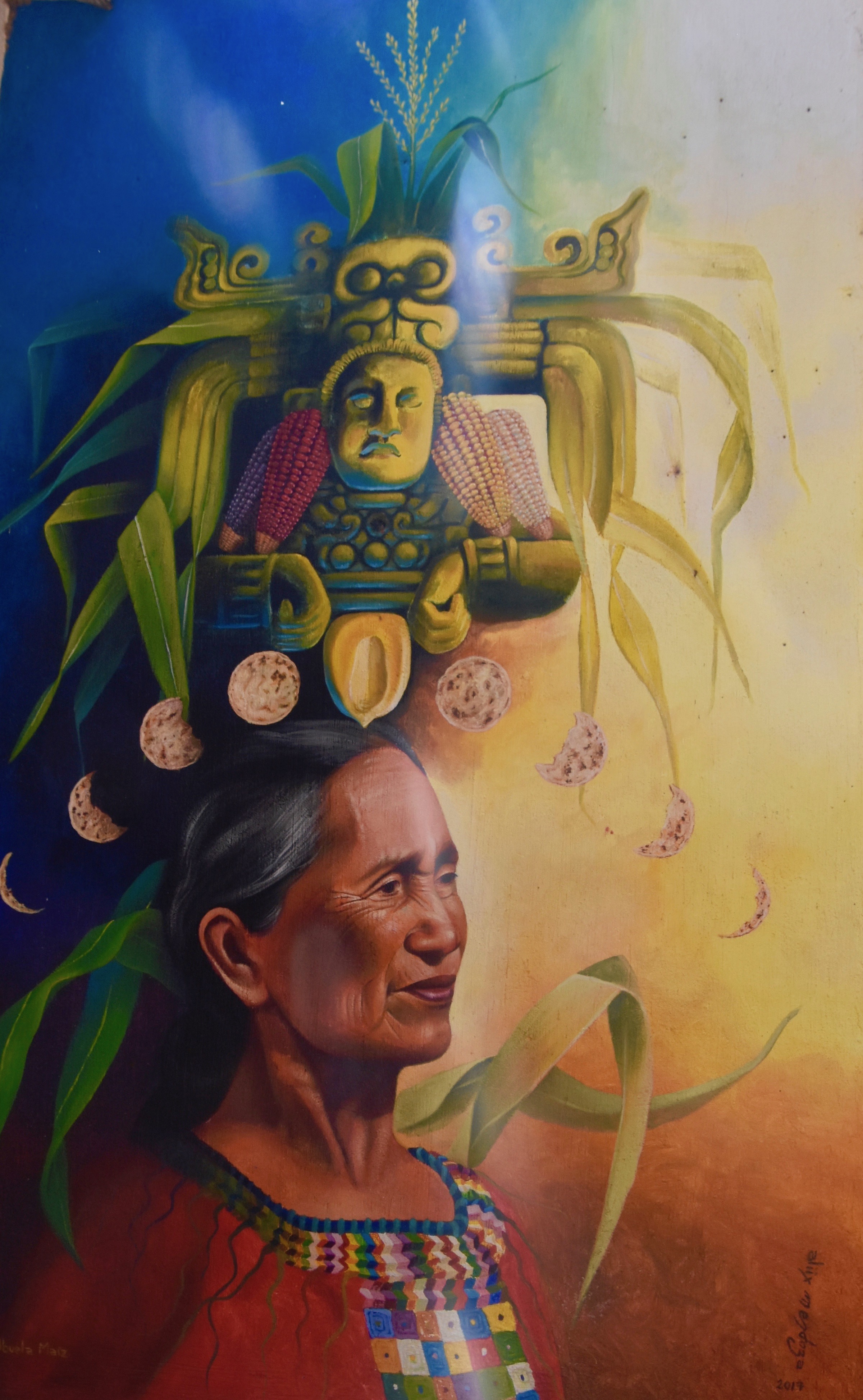
This one you look down at from above and some of them look back at you.
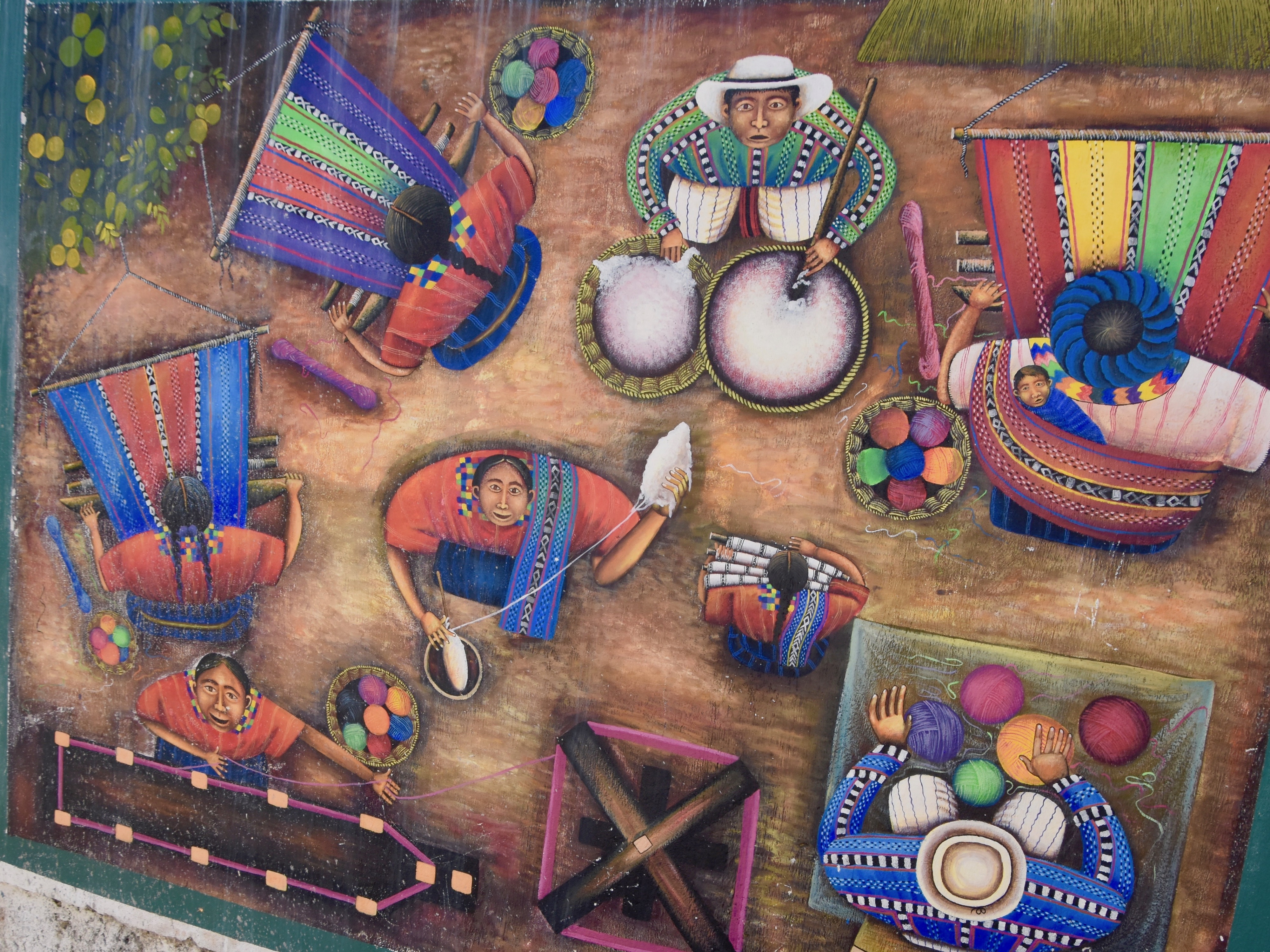
The town is also noted for its pottery, which would definitely make for a good souvenir of the place.
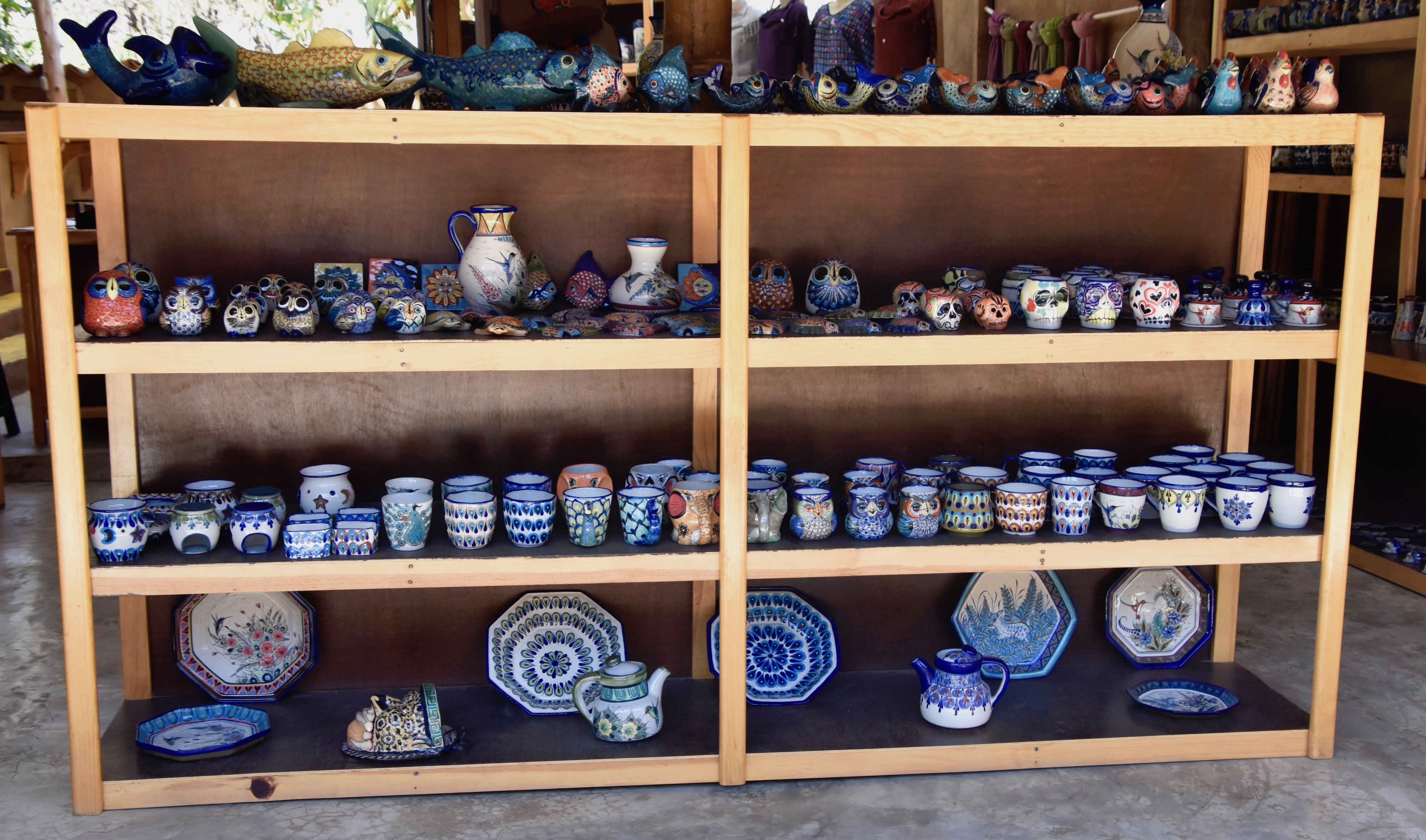
This wood collector emerged from the shadows of a narrow lane presumably to sell his wares in the town.
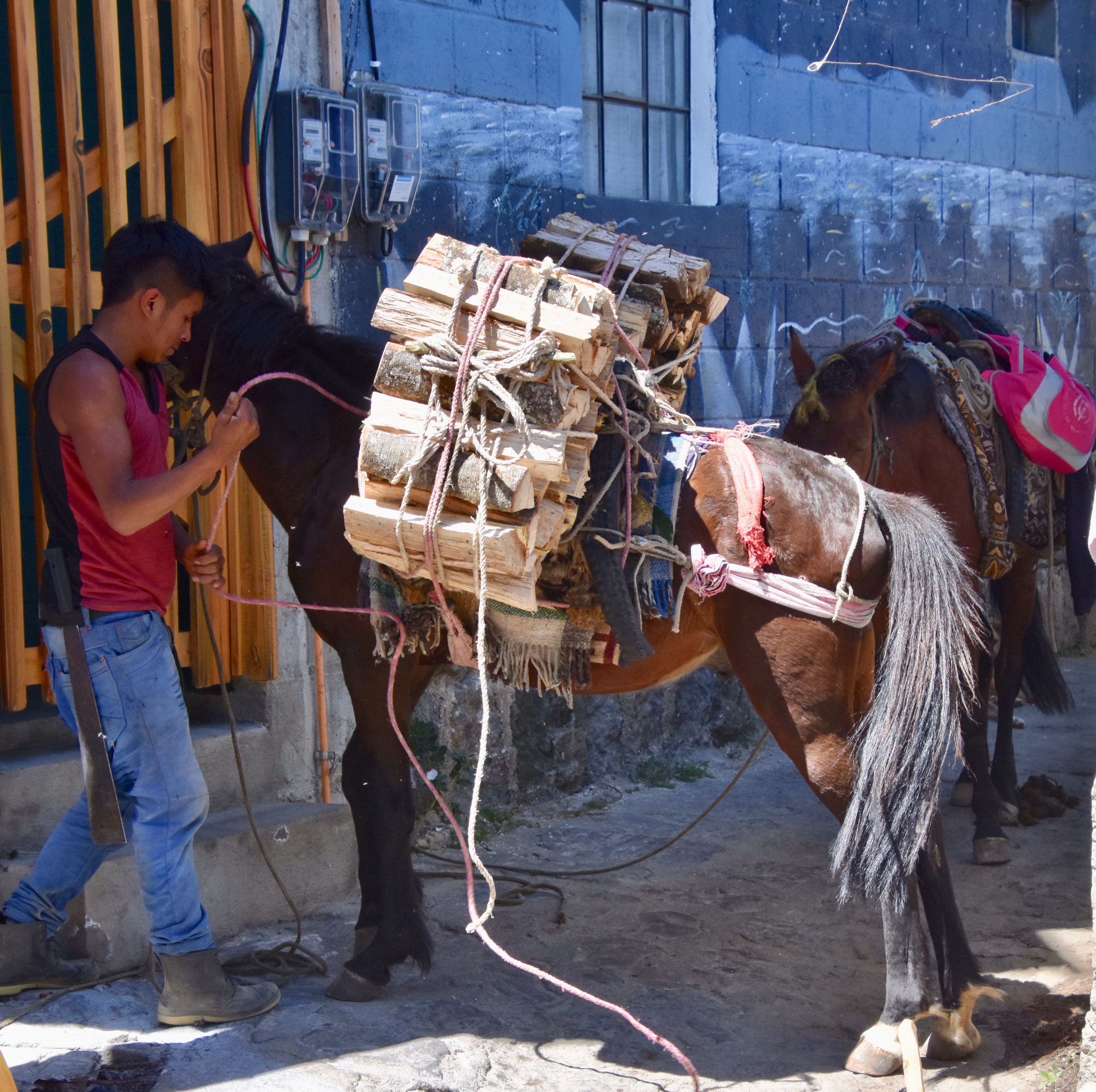
After visiting the church we made our way back to the boat and headed for Panajachel. Nearing the town we saw these tree enormous buildings that were totally out of sync with everything else on or around Lake Atitlan. Of course there was a story behind them and as with many things in Guatemala, corruption was the theme.
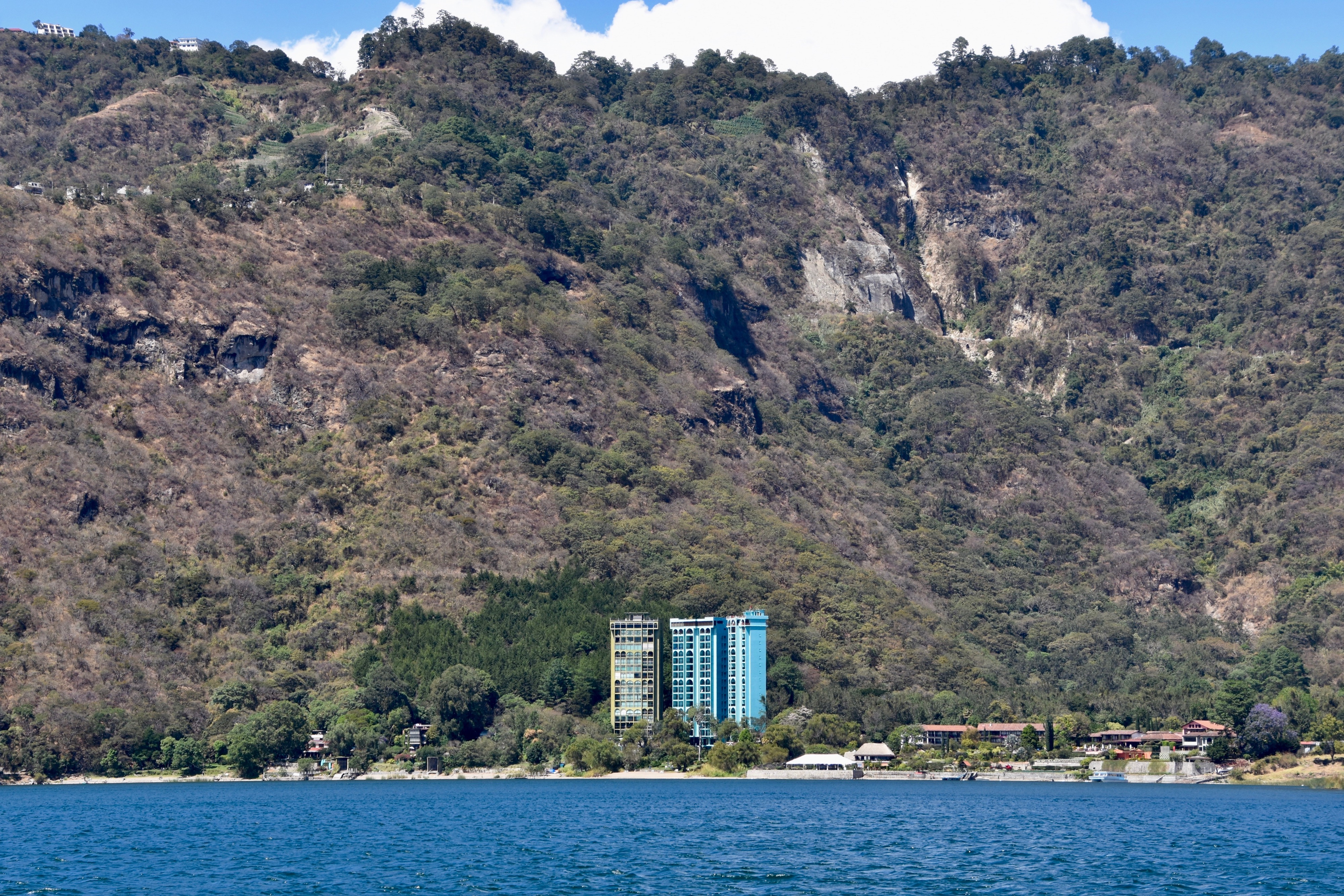
Even though Lake Atitlan was supposed to be protected from developments of this kind, the former Nicaraguan dictator Anastasio Somoza, hoping to launder some of the money he had stolen from his people, bribed officials in Guatemala to let him build these three buildings that were supposed to be condos. They got built, but Somoza didn’t get a chance to sell the condos as he was assassinated in Paraguay after being ousted by the Sandanistas. Two of them have never been occupied while the third apparently has a lot of squatters. And so goes life on Lake Atitlan.
This is an incredible place and I can only hope that the wheel of fortune favours it more in the future than it has in the recent past. I will long remember our magical day on this too, too beautiful lake.
Next we are off to Antigua which has long been on my bucket list of Spanish colonial cities. Hope to see you there.

